#Nozomi Kubota
Text
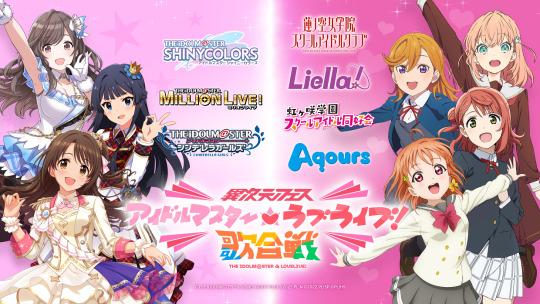
INTERDIMENSION FESTIVAL: IDOLM@STER★♥LOVE LIVE! UTA GASSEN
Information regarding the first IJIGEN FES 2023 live has been revealed! The live will occur in the TOKYO DOME on the 9th and 10th of December 2023. This first fes will feature three branches of IDOLM@STER performing with four branches of Love Live!
The voice providers participating in this stop are as follows:
DAY 1 ONLY
IDOLM@STER CINDERELLA GIRLS
Kotomi Aihara (Shiki Ichinose), Hiromi Igarashi (Anzu Futaba), Asami Takano (Frederica Miyamoto), Yuki Nakashima (Yuuki Otokura), Yuko Iida (Kanade Hayami), Honoka Inoue (Nanami Asari), Sumire Uesaka (Anastasia), Aya Suzaki (Minami Nitta), Miyu Tomita (Akira Sunazuka), Ru Thing (Syuko Shiomi), Teru Ikuta (Natalia), Hina Tachibana (Nagi Hisakawa), Nanami Yamashita (Yui Ohtsuki)
IDOLM@STER MILLION LIVE
Haruka Yamazaki (Mirai Kasuga), Azusa Tadokoro (Shizuka Mogami), Machico (Tsubasa Ibuki), Momo Asakura (Serika Hakozaki), Kotori Koiwai (Tomoka Tenkubashi), Atsuki Nakamura (Roco Handa), Emi Hirayama (Reika Kitakami), Yui Watanabe (Nao Yokoyama)
IDOLM@STER SHINY COLORS
Karin Isobe (Kogane Tsukioka), Chisa Suginuma (Mamimi Tanaka), Anna Yamaki (Sakuya Shirase), Shio Watanabe (Yuika Mitsumine), Yuina Mizuki (Kiriko Yukoku), Honoka Kuroki (Amana Osaki), Ryoko Maekawa (Tenka Osaki), Noriko Shibasaki (Chiyuki Kuwayama), Yuu Wakui (Toru Asakura), Rio Tsuchiya (Madoka Higuchi), Saran Tajima (Koito Fukumaru), Miho Okasaki (Hinana Ichikawa), Azusa Shizuki (Nichika Nanakusa), Aya Yamane (Mikoto Aketa)
DAY 2 ONLY
IDOLM@STER CINDERELLA GIRLS
Ayaka Ohashi (Uzuki Shimamura), Ayaka Fukuhara (Rin Shibuya), Sayuri Hara (Mio Honda), Amina Sato (Arisu Tachibana), Tomoyo Kurosawa (Miria Akagi), Hana Tamegai (Risa Matoba), Makoto Koichi (Haru Yuuki), Asaka Imai (Chie Sasaki), Natsumi Haruse (Kaoru Ryuzaki), Misaki Kuno (Nina Ichihara), Yuri Komori (Koharu Koga), Mina Nakazawa (Yukimi Sajo), Maki Hanatani (Kozue Yusa)
IDOLM@STER MILLION LIVE
Aimi (Julia), Miku Itou (Yuriko Nanao), Ibuki Kido (Kana Yabuki), Arisa Kori (Kaori Sakuramori), Yuri Komagata (Sayoko Takayama), Rie Suegara (Fuka Toyokawa), Saki Minami (Tsumugi Shiraishi), Rikako Yamaguchi (Rio Momose)
IDOLM@STER SHINY COLORS
Hitomi Sekine (Mano Sakuragi), Reina Kondo (Hiori Kazano), Mayu Mineda (Meguru Hachimiya), Hiyori Konno (Kaho Komiya), Haruka Shiraishi (Chiyoko Sonoda), Mariko Nagai (Juri Saijo), Wakana Maruoka (Rinze Morino), Akiho Suzumoto (Natsuha Arisugawa), Yuki Tanaka (Asahi Serizawa), Eri Yukimura (Fuyuko Mayuzumi), Sayaka Kitahara (Mei Izumi), Rina Kawaguchi (Luca Ikaruga), Haruna Mikawa (Hana Suzuki), Rena Ozawa (Haruki Iketa)
DAY 1&2
AQOURS (LOVE LIVE! SUNSHINE!!)
Anju Inami (Chika Takami), Rikako Aida (Riko Sakurauchi), Nanaka Suwa (Kana Matsuura), Arisa Komiya (Dia Kurosawa), Shukai Saito (You Watanabe), Aika Kobayashi (Yoshiko Tsushima), Kanako Takatsuki (Hanamaru Kunikida), Aina Suzuki (Mari Ohara), Ai Furihata (Ruby Kurosawa)
NIJIGASAKU SCHOOL IDOL CLUB
Aguri Ohnishi (Ayumu Uehara), Mayu Sagara (Kasumi Nakasu), Kaori Maede (Shizuku Osaka), Miyu Kubota (Karin Asaka), Natsumi Murakami (Ai Miyashia), Akari Kito (Kanata Konoe), Coco Hayashi (Setsuna Imura), Maria Sashide (Emma Verde), Chiemi Tanaka (Rina Tennoji), Moeka Koizumi (Shioriko Mifune), Shu Uchida (Mia Taylor), Akina Homoto (Zhong Lanzhu).
Support Member: Hinaki Yano (Yu Takasaki)
Liella! (LOVE LIVE! SUPERSTAR!!)
Sayuri Date (Kanon Shibuya), Liyuu (Keke Tang), Nako Misaki (Chisato Arashi), Naomi Payton (Sumire Heanna), Nagisa Aoyama (Ren Hazuki), Nozomi Suzuhara (Kinako Sakurakoji), Akana Yabushima (Mei Yoneme), Wakana Okuma (Shiki Wakana), Aya Emori (Natsumi Onitsuka), Yuina (Wien Margarete), Sakura Sakakura (Tomari Onitsuka)
HASUNOSORA SCHOOL IDOL CLUB
Nirei Nozomi (Kaho Hinoshita), Kokona Nonaka (Sayaka Murano), Nina Hanamiya (Kozue Otomune), Kotoka Sasaki (Tsuzuri Yugiri), Kanna Kan (Rurino Osawa), Kona Tsukine (Megumi Fujishima)
41 notes
·
View notes
Photo

NarutoxNozomi in Tokyo Mew Mew style.
💕 That moment when you find solace in your lover’s arms. 💕
#narutoxoc#NarutoxNozomi#nozomi kubota#naruto oc#Dimensional Mew Mew#Naruto Tokyo Mew Mew AU RP#my art
7 notes
·
View notes
Photo
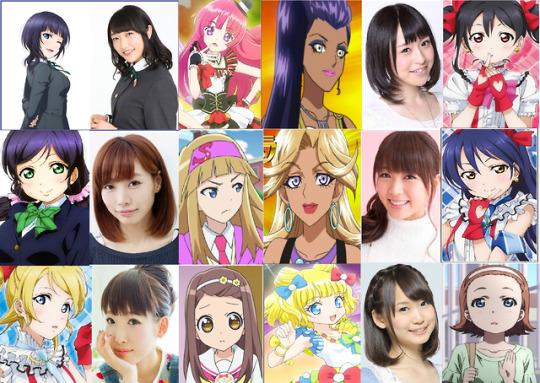
love live and pripara share seiyuu
miyutan voice karin asaka and sopie hojo
kussun voice nozomi tojo and sadako gozen
nanjolno voice eli ayase and nao ehime
soramaru voice nico yazawa and Britney as part of celebrity 4
mimorin voice umi sonoda and cera as part of celebrity 4
Yū SERIZAWA voice mutsu and mirei minami
#miyutan#miyu kubota#karin asaka#sophie hojo#aina kusuda#kussun#nozomi tojo#sadako gozen#Yoshino Nanjo#eli ayase#nao ehime#nanjolno#sora tokui#soramaru#nico yazawa#britney#mimorin#mimori suzuko#cera#umi sonoda#yu serizawa#mutsu#mirei minami#pripara#love live#love live sunshine#love live perfect dream project#love live seiyuu#love live sunshine seiyuu#love live perfect dream project seiyuu
16 notes
·
View notes
Text
2020 Olympics Japan Roster
Archery
Kawata Yūki (Hiroshima)
Muto Hiroki (Tokyo)
Furukawa Takaharu (Aomori)
Nakamura Miki (Yokohama)
Azusa Yamauchi (Tokyo)
Hayakawa Ren (Tokyo)
Athletics
Bruno Dede (Matsumoto)
Koike Yūki (Otaru)
Tada Shūhei (Higashiōsaka)
Yamagata Ryōta (Hiroshima)
Abdul Sani-Brown (Sokado)
Iizuka Shōta (Omaezaki)
Yamashita Jun (Tsukuba)
Julian Walsh (Hiroshima)
Bandō Yūta (Sumoto)
Hiroki Matsueda (Tokyo)
Akira Aizawa (Sukagawa)
Tatsuhiko Ito (Hamamatsu)
Ryoma Aoki (Kuki)
Ryūji Miura (Hamada)
Yamaguchi Kōsei (Higashiura)
Izumiya Shunsuke (Kanagawa)
Kanai Taiō (Hakodate)
Takayama Shun'ya (Hiroshima)
Abe Takotoshi (Tokyo)
Kazuki Kurokawa (Shimonoseki)
Hiromu Yamauchi (Aizuwakamatsu)
Kiryū Yoshihide (Hikone)
Rikuya Itō (Funabashi)
Kaito Kawabata (Matsusaka)
Satō Kentarō (Tokorozawa)
Aoto Suzuki (Saitama)
Shogo Nakamura (Yokkaichi)
Ōsako Suguru (Machida)
Yuma Hattori (Tōkamachi)
Ikeda Kōki (Hamamatsu)
Takahashi Eiki (Hanamaki)
Yamanishi Toshikazu (Kyoto)
Hayato Katsuki (Chukushino)
Masatora Kawano (Hyuga)
Satoshi Maruo (Kyoto)
Hashioka Yūki (Saitama)
Shiroyama Shōtarō (Hakodate)
Tsuha Hibiki (Kawagoe)
Takashi Etō (Mie)
Tobe Naoto (Noda)
Ejima Masaki (Kanagawa)
Yamamoto Seito (Okazaki)
Takuto Kominami (Sapporo)
Yu Ishikawa (Isehara)
Ran Urabe (Tokyo)
Tanaka Nozomi (Ono)
Kaede Hagitani (Saku)
Hironaka Ririka (Nagasaki)
Andō Yuka (Toyokawa)
Niiya Hitomi (Sōja)
Aoki Masumi (Okayama)
Kimura Ayako (Hiroshima)
Asuka Terada (Sapporo)
Yuna Yamanaka (Sakai)
Hanae Aoyama (Kobe)
Kodama Mei (Usuka)
Remi Tsuruta (Kagoshima)
Ami Saito (Takahashi)
Ichiyama Mao (Izumi)
Maeda Honami (Osaka)
Suzuki Ayuko (Toyohashi)
Fujii Nanako (Nakagawa)
Okada Kumiko (Ageo)
Kitaguchi Haruka (Asahikawa)
Boxing
Tanaka Ryōmei (Tokyo)
Sewon Okazawa (Tokyo)
Moriwaki Yuito (Tokyo)
Narimatsu Daisuke (Kumamoto)
Namiki Tsukimi (Narita)
Irie Sena (Tokyo)
Canoeing
Haneda Takuya (Toyota)
Adachi Kazuya (Tokyo)
Takanori Tōme (Tokyo)
Hiroki Fujishima (Kamikuishiki)
Yusuke Miyata (Wakayama)
Matsushita Momotarō (Komatsu)
Keiji Mizumoto (Yahaba)
Ayano Sato (Tokyo)
Yazawa Aki (Iida)
Teruko Kiriake (Yame)
Manaka Kubota (Kiyose)
Yuka Ono (Honjō)
Cycling
Arashiro Yukiya (Ishigaki)
Nariyuki Masuda (Sendai)
Nitta Yūdai (Aizuwakamatsu)
Wakimoto Yūta (Fukui)
Hashimoto Eiya (Gifu)
Yamamoto Kōhei (Makubetsu)
Nagasako Yoshitaku (Kasaoka)
Rim Nakamura (Kyoto)
Kaneko Hiromi (Yokkaichi)
Yonamine Eri (Osaka)
Kobayashi Yūka (Tosu)
Kajihara Yūmi (Saitama)
Kisato Nakamura (Chiba)
Miho Imai (Maebashi)
Sae Hatakeyama (Aigle, Switzerland)
Minato Oike (Shimada)
Diving
Terauchi Ken (Takarazuka)
Sakai Shō (Tokyo)
Reo Nishida (Osaka)
Tamai Rikuto (Takarazuka)
Hiroki Ito (Zama)
Murakami Kazuki (Ehime)
Mikami Sayaka (Yonago)
Arai Matsuri (Itami)
Haruka Enomoto (Utsunomiya)
Hazuki Miyamoto (Kōchi)
Itahashi Minami (Takarazuka)
Fencing
Tomohiro Shimamura (Tokyo)
Kaito Streets (Tokyo)
Kento Yoshida (Morioka)
Yudai Nagano (Ibaraki)
Kanō Kōki (Ama)
Minobe Kazuyasu (Echizen)
Yamada Masaru (Toba)
Uyama Satoru (Takamatsu)
Kyosuke Matsuyama (Tokyo)
Saitō Toshiya (Tokyo)
Shikine Takahiro (Tokyo)
Tokunan Kenta (Ikeda)
Rio Azuma (Osaka)
Tsuji Sumire (Gifu)
Nozomi Satō (Fukui)
Sera Azuma (Wakayama)
Yuka Ueno (Tokyo)
Aoki Chika (Minamiechizen)
Misaki Emura (Tokyo)
Norika Tamura (Mizuho)
Shihomi Fukushima (Munakata)
Rio Azuma (Wakayama)
Sumire Tsuji (Gifu)
Judo
Takatō Naohisa (Tokyo)
Abe Hifumi (Tokyo)
Ōno Shōhei (Naha)
Takanori Nagase (Ibaraki)
Mukai Shōichirō (Hongo)
Aaron Wolf (Shin-Koiwa)
Harasawa Hisayoshi (Shimonoseki)
Tonaki Funa (Sagamihara)
Abe Uta (Kobe)
Yoshida Tsukasa (Kyoto)
Tashiro Miku (Tokyo)
Arai Chizuru (Yorii)
Hamada Shōri (Kirishima Ichi)
Sone Akira (Kurume)
Karate
Naoto Sago (Tokyo)
Ken Nishimura (Fukuoka)
Araga Ryūtarō (Kyoto)
Kiyuna Ryō (Okinawa Ichi)
Miyahara Miho (Fukuoka)
Someya Mayumi (Tokyo)
Uekusa Ayumi (Tokyo)
Shimizu Kiyou (Osaka)
Pentathlon
Iwamoto Shōhei (Saga)
Tomonaga Natsumi (Saitama)
Rena Shimazu (Asaka)
Sailing
Nanri Kenji (Kanagawa)
Hokazono Junpei (Hioki)
Okada Keiju (Kitakyushu)
Koizumi Ibuki (Tokyo)
Leo Takahashi (Auckland, New Zealand)
Shibuki Iitsuka (Enoshima)
Tomizawa Makoto (Kashiwazaki)
Segawa Kazumasa (Sakaiminato)
Shibuki Iitsuka (Yokohama)
Anna Yamazaki (Hayama)
Eri Hatayama (Enoshima)
Sunaga Yuki (Sakado)
Doi Manami (Yokohama)
Yoshida Ai (Karatsu)
Yoshioka Miho (Enoshima)
Takano Sena (Suita)
Eri Hatayama (Zushi)
Shooting
Hiroyuki Ikawa (Tokyo)
Shigetaka Oyama (Toda)
Takayuki Matsumoto (Nagasaki)
Okada Naoya (Tsuyama)
Shiori Hirata (Kanagawa)
Haruka Nakaguchi (Kyoto)
Satoko Yamada (Saitama)
Kojiro Horimizu (Zentsūji)
Hiroyuki Ikawa (Yokohama)
Dai Yoshioka (Kyoto)
Ishihara Naoko (Tokyo)
Nakayama Yukie (Yūki)
Shiori Hirata (Nomi)
Haruka Nakaguchi (Kusatsu)
Chizuru Sasaki (Morioka)
Satoko Yamada (Kōka)
Softball
Fujita Yamato (Sasebo)
Ueno Yukiko (Fukuoka)
Goto Miu (Nagoya)
Mine Yukiyo (Fukuoka)
Kiyohara Nayu (Osaka)
Agatsuma Haruka (Tokyo)
Ichiguchi Yūka (Kanagawa)
Yamamoto Yū (Tokyo)
Hitomi Kawabata (Tokyo)
Atsumi Mana (Hamamatsu)
Minori Naito (Osaka)
Saki Yamazaki (Kakegawa)
Harada Nodoka (Sōja)
Mori Sayaka (Tokyo)
Yamada Eri (Fujisawa)
Climbing
Harada Kai (Kanagawa)
Narasaki Tomoa (Utsunomiya)
Noguchi Akiyo (Ibaraki)
Nonaka Mihō (Tokyo)
Surfing
Kanoa Igarashi (Huntington Beach, California)
Ōhara Hiroto (Chiba)
Maeda Mahina (Pupukea, Hawaii)
Tsuzuki Amuro (Shōnan)
Swimming
Honda Tomoru (Yokohama)
Ikari Yūki (Okayama)
Mura Ryūya (Yonago)
Shoma Sato (Tokyo)
Akira Namba (Yokkaichi)
Takahashi Kōtarō (Shizuoka)
Hagino Kōsuke (Oyama)
Irie Ryōsuke (Tennōji-Ku)
Kawamoto Takeshi (Nagoya)
Matsumoto Katsuhiro (Kanamachi)
Mizunuma Naoki (Tochigi)
Nakamura Katsumi (Tokyo)
Seto Daiya (Moroyama)
Sunama Keita (Yamatokoriyama)
Seki Kaiya (Tokyo)
Shioura Shinri (Isehara)
Miyu Namba (Yamaguchi)
Ageha Tanigawa (Tokyo)
Nagisa Ikemoto (Tokyo)
Aoi Masuda (Kobe)
Minamide Taishin (Kainan)
Yanagimoto Kōnosuke (Imari)
Konishi Anna (Toyooka)
Aoki Reona (Tokyo)
Hasegawa Suzuka (Kita)
Kobori Waka (Nara)
Ōhashi Yui (Hikone)
Teramura Miho (Nagareyama)
Watanabe Kanako (Tokyo)
Igarashi Chihiro (Kanagawa)
Ikee Rikako (Tokyo)
Ōmoto Rika (Kyoto)
Sakai Natsumi (Saitama)
Shirai Rio (Takarazuka)
Kida Yumi (Akasaka)
Namba Miyu (Nara)
Tanigawa Ageha (Shijonawate)
Ikemoto Nagisa (Uji)
Masuda Aoi (Kurashiki)
Inui Yukiko (Ōmihachiman)
Megumu Yoshida (Nagoya)
Fukumura Juka (Kyoto)
Kijima Moeka (Hakusan)
Okina Kyogoku (Higashioka)
Mayu Tsukamoto (Oamishirasato)
Mashiro Yasunaga (Higashioka)
Yanagisawa Akane (Saitama Ichi)
Table Tennis
Harimoto Tomokazu (Sendai)
Niwa Kōki (Tomakomai)
Mizutani Jun (Iwata)
Ishikawa Kasumi (Yamaguchi)
Itō Mima (Iwata)
Hirano Miu (Numazu)
Taekwondo
Ricardo Suzuki (Tokyo)
Sergio Suzuki (Tokyo)
Yamada Miyu (Aichi)
Hamada Mayu (Saga)
Volleyball
Ishijima Yūsuke (Matsubushi)
Shiratori Katsuhiro (Tokyo)
Shimizu Kunihiro (Fukui Ichi)
Ōnodera Taishi (Natori Ichi)
Fujii Naonobu (Miyagi Ichi)
Yamauchi Akihiro (Aichi Ichi)
Nishida Yūji (Inabe)
Sekita Masahiro (Tokyo)
Ishikawa Yūki (Aichi Ichi)
Lee Haku (Miyazaki Ichi)
Takanashi Kenta (Yamagata Ichi)
Ōtsuka Tatsunori (Osaka)
Yamamoto Tomohiro (Ebetsu)
Takahashi Ran (Kyoto)
Miki Ishii (Fujisawa)
Megumi Murakami (Echizen)
Ai Kurogo (Utsunomiya)
Koga Sarina (Saga)
Tasahiro Kanami (Ōtsu)
Mayu Ishikawa (Okazaki)
Shimamura Haruyo (Kamakura)
Kobata Mako (Kyoto)
Ishii Yuki (Kurashiki)
Mai Okumura (Nagatoro)
Araki Erika (Kurashiki)
Momii Aki (Sagamihara)
Hayashi Kotona (Kyoto)
Yamada Nichika (Toyota)
Wrestling
Otoguro Keisuke (Kōfu)
Otoguro Takuto (Kōfu)
Shohei Yabiku (Yokohama)
Fumita Ken'ichirō (Kōfu)
Takahashi Yūki (Kunawa)
Takatani Sōsuke (Kyōtango)
Yabiku Shōhei (Naha)
Susaki Yui (Matsudo)
Mukaida Mayu (Yokkaichi)
Kawai Risako (Tsubata)
Kawai Yukako (Tsubata)
Doshō Sara (Matsusaka)
Minagawa Hiroe (Uji)
Badminton
Momota Kento (Mitoyo)
Tsuneyama Kanta (Ōtsu)
Endō Hiroyuki (Tokyo)
Watanabe Yūta (Suginami)
Kamura Takeshi (Saga Ichi)
Sonoda Keigo (Yatsuhiro)
Yamaguchi Akane (Katsuyama)
Okuhara Nozomi (Ōmachi)
Fukushima Yuki (Kumamoto Ichi)
Hirota Sayaka (Kumamoto Ichi)
Matsumoto Mayu (Akita Ichi)
Nagahara Wakana (Akita Ichi)
Higashino Arisa (Iwamizawa)
Baseball
Kōyō Aoyagi (Yokohama)
Iwazaki Suguru (Shimizu)
Morishita Masato (Ōita Ichi)
Itoh Hiromi (Kayabe)
Yamamoto Yoshinobu (Bizen)
Tanaka Masahiro (Itami)
Yamasaki Yasuaki (Tokyo)
Kuribayashi Ryoji (Aisai)
Yūdai Ōno (Kyoto)
Senga Kodai (Gamagōri)
Taira Kaima (Ishigaki)
Umeno Ryūtarō (Nakagawa-Cho)
Kai Takuya (Ōita Ichi)
Yamada Tetsuto (Toyooka)
Genda Sōsuke (Ōita Ichi)
Asamura Hideto (Osaka)
Kikuchi Ryosuke (Tokyo)
Sakamoto Hayato (Itami)
Murakami Munetaka (Kumamoto Ichi)
Kondō Kensuke (Chiba Ichi)
Yanagita Yūki (Hiroshima)
Kurihara Ryōya (Fukui Ichi)
Yoshida Masataka (Fukui Ichi)
Suzuki Seiya (Tokyo)
Basketball
Togashi Yūki (Shibata)
Makoto Hiejima (Kyoto)
Hachimura Rui (Sendai)
Leo Vendrame (Nobeoka)
Watanabe Yūta (Zentsūji)
Kanamaru Kosuke (Fukuoka Ichi)
Baba Yūdai (Toyama Ichi)
Gavin Edwards (Funabashi)
Tanaka Daiki (Unzen)
Avi Schafer (Osaka)
Hugh Watanabe (Honolulu, Hawaii)
Harimoto Tenketsu (Nisshin)
Ira Brown (Willis, Texas)
Ochiai Tomoya (Tsuchiura)
Tominaga Akirasei (Nagoya)
Yasuoka Ryūto (Koshigaya)
Nagaoka Moeko (Urakawa)
Maki Takada (Toyohashi)
Miyoshi Naho (Ichikawa)
Rui Machida (Asahikawa)
Motohashi Nako (Tokyo)
Todo Nanako (Sapporo)
Hayashi Saki (Itoshima)
Evelyn Mawuli (Toyohashi)
Saori Miyazaki (Shibuya)
Miyazawa Yuki (Yokohama)
Akaho Himawari (Ishikawa)
Monica Okoye (Tokyo)
Stephanie Mawuli (Toyohashi)
Nishioka Risa (Ikoma)
Shinozaki Mio (Yokohama)
Yamamoto Mai (Hiroshima)
Equestrian
Takahashi Masanao (Tokyo)
Shingo Hayashi (Sapporo)
Hiroyuki Kitahara (Tokyo)
Kazuki Sado (Kyoto)
Kitajima Ryūzō (Kobe)
Ōiwa Yoshiaki (Schleswig Holstein, Germany)
Tanaka Toshiyuki (Fukuoka Ichi)
Kazuma Tomoto (Sturminster Newton, U.K.)
Mike Kawai (Valkenswaard, The Netherlands)
Fukushima Daisuke (Sakura)
Koki Saito (Katori)
Satō Eiken (Ogawa)
Field Hockey
Koji Yamasaki (Kōfu)
Genki Mitani (Echizen)
Tanaka Seren (Kyoto)
Ochiai Hiromasa (Tenri)
Murata Kazuma (Toyama Ichi)
Tanaka Kenta (Ōtsu)
Kitazato Kenji (Kumamoto Ichi)
Nagai Yūma (Kyoto)
Yamashita Manabu (Oyabe)
Tanaka Kaito (Tenri)
Nagayoshi Ken (Utsunomiya)
Fukuda Kentarō (Matsue)
Ōhashi Masaki (Nikkō)
Yamada Shōta (Maibara)
Zendana Hirotaka (Matsue)
Yoshikawa Takashi (Maibara)
Watanabe Kōta (Fukui Ichi)
Kirishita Yoshiki (Nara Ichi)
Kimika Hoshi (Kakamigahara)
Natsuhara Matsumoto (Matsubara)
Yu Asai (Hiroshima)
Mano Yukari (Kakamigahara)
Nagai Yuri (Kakamigahara)
Nagai Hazuki (Kakamigahara)
Oikawa Shihori (Tenri)
Kana Nomura (Nara)
Miki Kozuka (Nikko)
Segawa Maho (Tokyo)
Yamada Aki (Kōfu)
Nishikōri Emi (Matsue)
Kanon Mori (Hiroshima)
Mai Toriyama (Nara)
Sakurako Omoto (Iwakuni)
Asano Sakiyo (Kakamigahara)
Soccer
Ōsako Keisuke (Izumi)
Sakai Hiroki (Kashiwa)
Nakayama Yūta (Ryūgasaki)
Itakura Kō (Yokohama)
Yoshida Maya (Nagasaki)
Endoh Wataru (Yokohama)
Kubo Takefusa (Kawasaki)
Miyoshi Kōji (Kawasaki)
Maeda Daizen (Osaka)
Dōan Ritsu (Amagasaki)
Mitoma Kaoru (Kawasaki)
Tani Kosei (Osaka)
Hatate Reo (Shizuoka)
Tomiyasu Takehiro (Fukuoka Ichi)
Hashioka Daiki (Saitama)
Sōma Yūki (Tokyo)
Tanaka Ao (Kawasaki)
Ueda Ayase (Mito)
Hayashi Daichi (Osaka)
Machida Kōki (Mito)
Seko Ayuma (Osaka)
Zion Suzuki (Saitama Ichi)
Ikeda Sakiko (Saitama Ichi)
Shimizu Risa (Kobe)
Takarada Saori (Tateyama)
Kumagai Saki (Sapporo)
Minami Moeka (Yoshikawa)
Sugita Hina (Kitakyushu)
Nakajima Emi (Yasu)
Miura Narumi (Kawasaki)
Sugasawa Yuika (Chiba Ichi)
Iwabuchi Mana (Tokyo)
Tanaka Mina (Inagi)
Endō Jun (Shirakawa)
Shiokoshi Yuzuho (Saitama Ichi)
Hasegawa Yui (Toda)
Momiki Yūka (New York, New York)
Miyagawa Asato (Yokohama)
Kitamura Nanami (Osaka)
Yamashita Ayaka (Tokyo)
Shiori Miyake (Sapporo)
Hayashi Honoka (Uji)
Kinoshita Momoka (Hyogo)
Hirao Chika (Matsudo)
Golf
Matsuyama Hideki (Sendai)
Hoshino Rikuya (Mito)
Hataoka Nasa (Kasama)
Inami Mone (Tokyo)
Gymnastics
Hashimoto Daiki (Chiba)
Kaya Kazuma (Funabashi)
Kitazono Takeru (Osaka)
Wataru Tanigawa (Funabashi)
Daiki Kishi (Komatsu)
Ryosuke Sakai (Isehara)
Hatekeda Hitomi (Tokyo)
Hiraiwa Yūna (Tokyo)
Murakami Mai (Sagamihara)
Sugihara Aiko (Higashiōsaka)
Ōiwa Chisaki (Noda)
Sumire Kita (Tokyo)
Noshitani Sakura (Tokyo)
Sugimoto Sayuri (Nagoya)
Suzuki Ayuka (Anpachi)
Nanami Takenaka (Setagaya)
Yokota Kiko (Tokyo)
Hikaru Mori (Tokyo)
Megu Uyama (Kanazawa)
Handball
Naoki Sugioka (Kariya)
Yuta Iwashita (Kanazaki)
Kenya Kasahara (Kariya)
Adam Baig (Fukuoka Ichi)
Narita Kohei (Hiroshima)
Tokuda Shinnosuke (Inazawa)
Watanabe Jin (Ōita Ichi)
Rémi Feutrier (Tokyo)
Motoki Sakai (Isehara)
Motoki Shida (Kasumigauri)
Tatsuki Yoshino (Misato)
Agarie Yūto (Urasoe)
Mizumachi Kōtarō (Tokyo)
Rennosuke Tokuda (Iwakuni)
Yoshida Shūichi (Tarnow, Poland)
Sunami Kaho (Kagoshima)
Sunami Yui (Okayama)
Shiota Sayo (Takamatsu)
Yokoshima Aya (Takaoka)
Mana Horikawa (Hiroshima)
Itano Minami (Osaka)
Tanabe Yuki (Hakusan)
Ayaka Ikehara (Urasoe)
Hara Nozomi (Nobeoka)
Ōyama Mana (Takamatsu)
Sasaki Haruno (Takaoka)
Shiori Nagata (Fukuoka Ichi)
Sakura Hauge (Bergen, Norway)
Kondō Mahura (Tokyo)
Fujii Shio (Osaka)
Ishitate Mayuko (Fukui)
Rowing
Arakawa Ryūta (Yokohama)
Tomita Chiaki (Yonago)
Ōishi Ayami (Aichi Ichi)
Rugby
Jose Seru (Higashioka)
Lote Tuqiri (Namatakula, Fiji)
Colin Bourke (Tokyo)
Hano Kazushi (Nagoya)
Kameli Soejima (Labasa, Fiji)
Hikosaka Masakatsu (Aichi Ichi)
Brackin Karauria-Henry (Auckland, New Zealand)
Chihito Matsui (Osaka)
Ryota Kano (Tokyo)
Yoshikazu Fujita (Fukuoka Ichi)
Kippei Ishida (Amagasaki)
Naoki Motomura (Hachinohe)
Gōya Kazuhiro (Onojo)
Wakaba Hara (Niigata)
Rinka Matsuda (Kyoto)
Yume Hirano (Tokyo)
Haruka Hirotsu (Tokyo)
Marin Kajiki (Fukuoka Ichi)
Koide Mifuyu (Kumagaya)
Hana Nagata (Fukuoka Ichi)
Mei Otani (Kyoto)
Raichel Bativakalolo (Tokyo)
Mayu Shimizu (Tokyo)
Miyu Shirako (Tokyo)
Honoka Tsutsumi (Ureshino)
Skateboarding
Hirano Ayumu (Murakami)
Aoki Yukito (Shizuoka)
Horigome Yūto (Tokyo)
Shirai Sora (Sagamihara)
Hiraki Kokona (Kutchan)
Okamoto Misugu (Takahama)
Yosozumi Sakura (Iwade)
Nakayama Fūna (Toyama Ichi)
Nishimuri Aori (Tokyo)
Nishiya Momiji (Osaka)
Tennis
Tarō Daniel (Bradenton, Florida)
Nishikori Kei (Bradenton, Florida)
Nishioka Yoshihito (Tsu)
Sugita Yūichi (Tokyo)
Ben McLachlan (Queenstown, New Zealand)
Doi Misaki (Tokyo)
Hibino Nao (Ichinomiya)
Ōsaka Noami (Beverly Hills, California)
Aoyama Shūko (Osaka)
Shibahara Ena (Rancho Palos Verdes, California)
Ninomiya Makoto (Hiroshima)
Triathlon
Kenji Nener (Perth, Australia)
Makoto Odakura (Tokyo)
Niina Kishimoto (Kawagoe)
Takahashi Yūko (Mitaka)
Water Polo
Tanamura Katsuyuki (Ishigaki)
Adachi Seiya (Gifu Ichi)
Harukiirario Koppu (Tokyo)
Shiga Mitsuaki (Maebashi)
Takuma Yoshida (Nagahama)
Toi Suzuki (Yamagata Ichi)
Shimizu Yūsuke (Kumamoto Ichi)
Mitsuru Takata (Tokyo)
Arai Atsushi (Kawasaki)
Yusuke Inaba (Toyama)
Keigo Okawa (Yachiyo)
Kenta Araki (Tokyo)
Tomoyoshi Fukushima (Kagoshima Ichi)
Rikako Miura (Yamagata Ichi)
Yumi Arima (Yusashino)
Akari Inaba (Toyama)
Eruna Ura (Hakusan)
Kaho Iwano (Inabe)
Miku Koide (Kashiwazaki)
Maiko Hashida (Tokyo)
Yuki Niizawa (Tokyo)
Minori Yamamoto (Kyoto)
Kako Kawaguchi (Yokohama)
Marina Tokumoto (Tokyo)
Kyoko Kudo (Yokohama)
Minami Shioya (Yachiyo)
Weightlifting
Itokazu Yōichi (Tokyo)
Mitsunori Konnai (Setagaya)
Masanori Miyamoto (Naha)
Toshiki Yamamoto (Yokohama)
Miyake Hiromi (Niiza)
Yagi Kanae (Kobe)
Andō Mikiko (Shiroi)
#Sports#National Teams#Japan#Races#Fights#Boxing#Boats#New Zealand#Tennis#Switzerland#Hawaii#Baseball#Basketball#Texas#Animals#Germany#U.K.#The Netherlands#Hockey#Soccer#New York City#New York#Golf#Poland#Norway#Fiji#Florida#Australia
13 notes
·
View notes
Text
Watch Pripara VAs' Lovely Performances in "Pripara Friendship Autumn Live 2021" Digest Movie
Avex Pictures' official YouTube channel has started streaming an eight-minute digest movie of "Pripara Friendship Autumn Live 2021," the live concert performed by 26 main voice cast members of the PripPara and its sequel Idol Time Pripara anime franchise, held at J:COM Hall Hachiouji in Tokyo on September 25, 2021.
youtube
Performers:
Himika Akaneya (Laala Manaka)
Yu Serizawa (Mirei Minami)
Miyu Kubota (Sophy Hojo)
Saki Yamakita (Sion Todo)
Azuki Shibuya (Dorothy West)
Yuki Wakai (Reona West)
Yui Makino (Aroma Kurosu)
Yui Watanabe (Mikan Shiratama)
Asami Sanada (Gaaruru)
Mitsuki Saiga (Hibiki Shikyoin)
Falulu (Chinatsu Akasaki)
Azusa Sato (Fuwari Midorikaze)
Non Manaka (Minami Tanaka)
Nichika Omori (Chili Tsukigawa)
Pepper Taiyo (Nanami Yamashita)
Cosmo Hojo (Nozomi Yamamoto)
Reina Ueda (Ajimi Kiki)
Arisa Date (Yui Yumekawa)
Yo Daichi (Nino Nijiiro)
Yuina Yamada (Michiru Kouda)
Madoka Asahina (Shuuka Hanazono)
Seiichiro Yamashita (Shougo Yumekawa)
Tatsuyuki Kobayashi (Asahi Mitaka)
Reiou Tsuchida (Koyoi Takase)
Kentaro Kawai (Shinya Oedo)
Shotaro Uzawa (Ushimitsu)
The Blu-ray disc of the concert is set to be released on March 18, 2022.
Blu-ray jacket:
Source: Avex Pictures offcial YouTube channel
© T-ARTS / syn Sophia / TV Tokyo/ IPP Production Committee
By: Mikikazu Komatsu
3 notes
·
View notes
Photo



“good morning” Ayumi Takahashi
group exhibition “good morning” at MOUNT tokyo
2021.01.27-02.07
IONA , Haruka Ikeda , Nobue Kubota , Rie Kuriyama , Yumi Shirai , Misako Totsuka , Nozomi , Ayumi Takahashi
9 notes
·
View notes
Text
My Review of Love Live Nijigasaki School Idol Club
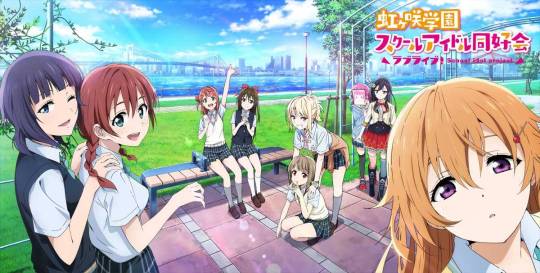
AAAAAAAAAAAAH!
I’M BACK IN IDOL HELL!
Another damn Love Live! Seriously? Another damn one!?
Actually, I knew this was going to happen from like almost two years ago. Back when I was an active player with the rhythm game app LLSIF, we’d get these special characters popping in every now and then, usually as SSR, SR, or N scouts. Then in 2019, they put out singles for each girl to play and I knew then and there that a new Love Live was already in the works and were going to feature these girls.
THIS STORY: First of all, the characters of this story are not becoming idols because the school is in danger of closing down. I know that was like a big thing in the original Love Live and in Sunshine, but that’s not the case this time. This school looks very well populated and well-established. So let’s just squash that trope.

Ayumu and Yuu got bit by the idol bug leaving school one day when they came across a solo performance out in the open. The girl performing is named Setsuna Yuki and she’s part of the Idol Club at Nijigasaki (the school Ayumu and Yuu attend). The next day, they learned from the student council that the club has been disbanded at the request of Setsuna. So what do Ayumu and Yuu do now? They’re going to try and revive it!

But what about the girl who started the idol club in the first place, Setsuna?! The reason for Setsuna disbanding the club was because she felt that she and the rest of the girls in the group were on a different wavelength. So she decided to disban the club, leaving the other girls, Emma, Kanata, Shizuku, and Kasumi to go their separate ways. But that wasn’t the only thing on Setsuna’s plate. Setsuna kinda lives a double life on campus. She’s Setsuna in the school idol club, but she’s also the student council president, Nana. So Ayumu, Yuu, and Setsuna end up reviving the idol club. Emma, Kasumi, Shizuku, and Kanata end up joining again. And eventually, we get other members Ai, Rina, and Karin to join in. And since there’s quite a long list of characters, let’s talk about them.
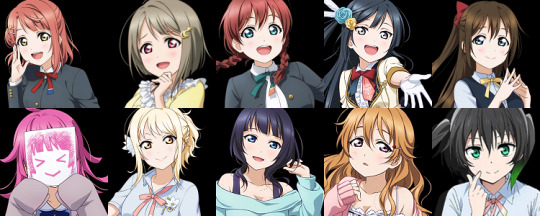
Ayumu is one of the first girls to revive the idol club. Unlike the main girls from the other series like Honoka and Chika, she’s not as crazy-energetic and idol-crazy. She’s more of the lover of cute things. She was sparked by idols when she saw Setsuna perform.
Speaking of cute things, Kasumi is the idol-loving crazy girl that loves all things cute and wants all of her performances to be cute.
Emma is the first Love Live character originally from a place that’s not Japan. This Swiss-miss came to Japan to become an idol.
Setsuna lives the double life. At school, she’s the disciplinarian student council president, Nana. But when she’s in idol form, she’s Setsuna Yuki ready to shine on stage.
Shizuku got interested in becoming an idol to help with her acting aspirations.
Rina got curious and ended up joining the idol club despite having problems showcasing her emotions. That’s why you see the computerized monitor on her face.
Ai joined alongside with Rina and with her Sporty Spice persona, she’ll get the club on their feet.
Karin is already well-established in the modeling world, but ended up getting into the idol world after hanging with Emma.
Kanata…likes to sleep. Oh, and she has a younger sister in an idol group at her school.
Then there’s Yuu! She isn’t the kind of idol member that sings and performs like the other girls, but works to support each girl in their goals.
Oh and all of these idols are SOLO ARTISTS!
BETWEEN THE SUB AND THE DUB: As usual with the Love Live franchise (and most other idol animes), these voice actors are brand-spankin’ new. These girls are usually only known for their work as actual idols and only a few of them really go on to do a full-length voice actor career. Then I get, SURPRISE! Akari Kitou is in this too! This girl was in EVERYTHING these past two years! Everything! Every-damn-thing! Now she’s a Love Live waifu! Actually, several of the seiyuus here I’ve seen in a few things here and there and that’s pretty rare since I’m not hip to all the idol groups in Japan.
Now for the dub, because we all know FUNimation! Yeah, they licensed this just like the previous Love Live series. However, they really kept this series all to themselves where not even Hulu could air it. At the moment, no dub has been announced or planned. I’m assuming it’ll happen one day. I only say this because of all the other Love Live series. Here’s what you might recognize these folks from.
*Ayumu is played by Aguri Oonishi
*Setsuna is played by Tomori Kusunoki (known for LLENN on SAO: Gun Gale Online)
*Kasumi is played by Mayu Sagara
*Ai is played by Natsumi Murakami
*Emma is played by Maria Sashide
*Rina is played by Chiemi Tanaka (known for Ririko on Sakura Quest)
*Kanata is played by Akari Kitou (known for Nezuko on Demon Slayer, Yashiro on Toilet-Bound Hanako-kun, Iwanaga on In/Spectre, Tsukasa on Tonikawa, Aru on Hitoribocchi, and Kaho on Blend-S)
*Shizuku is played by Kaori Maeda (known for Selka on SAO: Alicization)
*Karin is played by Miyu Kubota (known for Sister Lily on Black Clover)
*Yuu is played by Hinaki Yano
NEW BEST GIRL: As you may know, I have picked my favorite girls from the Love Live fandom. Nozomi is best girl in the original and when it comes to Sunshine, Ruby is tops!
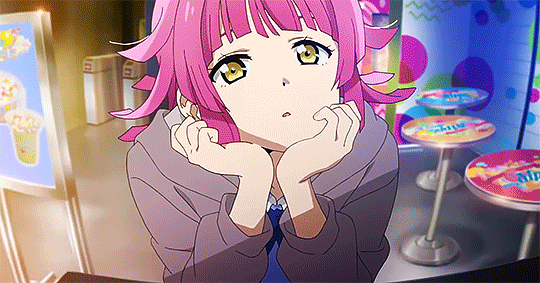
When I saw the new girls back when the app LLSIF released all the single songs for the Nijigasaki club, I was curious about one particular girl. I had a feeling Rina was going to be a special kind of interesting. Why was she wearing a special mask on stage? Is she an introvert who hates to be seen up-close? I had to learn more about her! Turns out Rina had a lot of trouble expressing her feelings. When she’s excited, sad, irritated, or satisfied, it’s just the same expression. I love Rina. She’s my precious cinnamon roll and if anyone talks smack about her is gonna get a bop in the face.
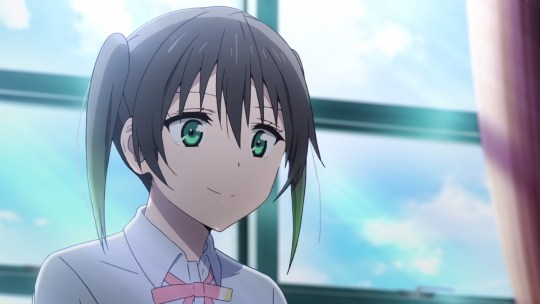
ABOUT YUU: I know what you’re thinking, what the hell is going on with Love Live giving us 10 girls instead of 9? And I would agree! LLSIF game gave us 9 solo albums and Yuu is not among any of them. But then I recently downloaded LLSIF All Stars and discovered the interactive portion with all of the girls and how your character is the unspoken 10th member of the group. Yeah, Yuu is pretty much that character.
SHIPPING: In the original series, I was a bit of a multi-shipper that was open to any hookups if I can see it. When Sunshine came along, I was still a multi-shipper, but heavily Kanan x Mari to a point where I’m imagining their wedding. This time around…yeah, once again I found myself shipping the fuck out of third-years.

This is Karin x Emma. I support the fuck out of this. Never forget that!

And while I’m at it, let’s add Ai x Rina. Ai was literally Rina’s first friend. She will go anywhere for this girl and do anything for her.
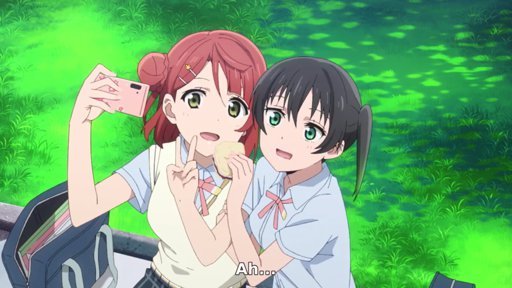
I should probably add Ayumu x Yuu too. But then again, this is Love Live. No matter what ship we all choose, it’s all for naught as no one really confesses their feelings for each other. Right?
Hahaha…Foreshadowing!

THE SAME, BUT…: Yeah, you know how this goes. Since this is an idol anime and the third one from the same franchise, I’m gonna squawk about the similarities this series has with the first two Love Lives. Yes, we’ve got the cutesy, annoying idol with Kasumi. Yes, we have the token class president with Setsuna. Yes, the animation for all the dance scenes is wonky CGI. And yes, we have a center second year with a red-ish hue to her hair with Ayumu. But there’s just so many glaring differences compared to the other two series.
*First of all, the school is not in any danger of closing down. The original Love Live had Honoka and her friends starting a school idol club to drum up attention for their school so it wouldn’t have to shut down. Love Live Sunshine also had that with sadder outcomes for the school. This school is huge, has many different clubs and activities. This school is safe! But if they pull some shit out in season two saying it has to close down, I call bullshit.
*Nijigasaki High School Idol Club mostly has solos. One of the reasons for the falling out at the beginning between Setsuna, Kasumi, Emma, Kanata, and Shizuku was differences. Every girl has their own thing and they respect that. Even in the app, there are a lot of solo songs and only a few where two or more of the girls are singing together.
*Add to that, this group doesn’t really have a “group name”. I mean Nijigasaki School Idol Club doesn’t exactly roll off the tongue like μ's or Aqours.
*The big, scary student council president is a second year. Unlike Eli and Dia from the previous series, Setsuna (a second year student) is really the scary one with power. But much like Dia, she does have a passion for idols. It’s just that Setsuna goes above and beyond to hide that along with her true self. I bring this up because when the second season comes (AND IT WILL), I have a feeling they’ll introduce this one character that’s in the game and that’s going to be quite the game changer.
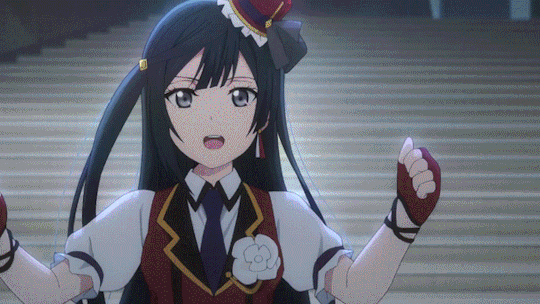
FAVORITE SONG: Chase by Setsuna.
I think all of us were blown away by that song in episode one.
ENDING: After Diver Fes and Karin’s solo performance, the girls decide to hold a training camp at their school. During the camp, Yuu was still awe-struck by everyone’s dedication to the club and the performances in the previous episode. And by the end of the camp, Yuu says there should be a school idol festival to show everyone that school idols are awesome. Much to my dismay, I doubt that this anime will follow the game route and have μ's and Aqours perform. Actually, the groups seen throughout the series are characters I would run across in one of the other Love Live apps, including Kanata’s little sister. Moving on!

Everything was going along swimmingly with this School Idol Festival. The student council (or Setsuna as her alter ego Nana) agreed to it, the students of Nijigasaki are excited for what’s to come, and other schools including Kanata’s sister Haruka’s school are willing to participate. However, the big friction that sparked came from Ayumu. As we all know, she and Yuu are close as can be. Ever since the resurrection of the School Idol Club, Yuu has been there to realize the dreams of everyone. Ayumu got jealous, especially seeing Yuu with Setsuna. So she corners her and wants Yuu all to herself and…

Whoa. Confirmed lesbianism!
Let’s just say Ayumu’s jealousy came and went as she realized she can’t stop Yuu’s dreams and that Ayumu’s gonna have plenty of devoted fans besides Yuu. So thankfully that was resolved quicker than I thought and now we can focus on the School Idol Festival. The festival was actually going really well. There were separate stages for all of the solo idols and there were sample songs from all the Nijigasaki girls heard throughout the finale, and only a few hiccups during the day. But nothing Rina couldn’t fix. So much for the rainstorm!
Oh come on guys, plenty of idols from this franchise and other shows performed in the rain and they all turned out just fi…
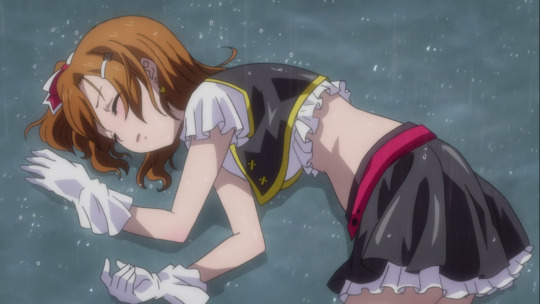
Oh, I forgot about Honoka.
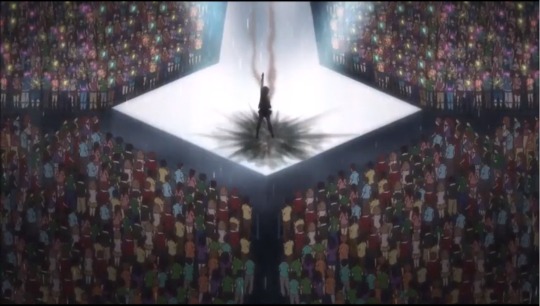
Oof. Zombieland Saga did her wrong. Never mind what I said!
Unfortunately, the rain didn’t clear up until 7:05 (five minutes after the time allowed for this festival). But all of these idol fans waited and they wanted a show. And so, that’s what they got. Nijigasaki and all the other participating schools performed together. So the festival was a big hit. People who watched it sent a request for another festival to happen. So there’s definitely going to be another School Idol Festival in their future. But what about a season two?
Pfft. COME ON! You know there’s going to be a season two. The girls haven’t experienced heartache of the upperclassmen graduating. Shioriko hasn’t been introduced yet. Tokimeki Runners hasn’t been sung yet. An actual Love Live hasn’t happened yet. That is the whole point of this franchise, right? To have idols participate in the famous Love Live School Idol Festival? So yeah, I know no one has greenlit the Nijigasaki series or announced anything, but I know it’s gonna happen. I can smell it. Love Live will never die. Why else is there going to be a Love Live Superstar series coming out in July?
I gotta say I enjoyed this series. It’s nice to see the struggle of creative differences with the club members. I mean in the past two series, the girls would all agree to something or eventually get to a happy conclusion and sing together in perfect harmony. Cute, but not realistic! And these girls are all very different so it’s good to see a lot more solo performances. Both μ's and Aqours have members with solo songs. It’s just that if you’re an anime only person, you probably wouldn’t know that. Otherwise you would know that Riko and Maki are superior in the singing department.
Prove me otherwise!
Recommendations are always tricky in this area. Idol shows are either loved or hated by the anime community. And I unfortunately can only recommend this to idol show watchers. I’ve already stuck my neck out to recommend Zombieland Saga to everyone.
If you would like to watch Love Live Nijigasaki High School Idol Club (fuck that’s a mouth-full), it is available for streaming only on FUNimation.
#anime review#love live#love live nijigasaki high school idol club#setsuna yuki#ayumu uehara#kanata konoe#rina tennoji#kasumi nakasu#emma verde#shizuku osaka#ai miyashita#karin asaka#yuu takasaki
8 notes
·
View notes
Text
Precure Day 169
Episode: Yes! Precure 5 21 - “Milk the Apprentice Caregiver Appears!”
Date watched: 5 January 2020
Original air date: 1 July 2007
Screenshots: https://imgur.com/a/3Lt6N6V
Transformation Gallery: https://imgur.com/a/6k6SzS0
Project info and master list of posts: http://tinyurl.com/PCDabout
vimeo
I just want you to know it took me a couple hours to cut out the faces and then another hour of video editing to figure out this program I’ve never used before in order to make that 10 second clip, so I hope you appreciate it. THESE ARE THE THINGS I DO FOR ART.
Anyway, what can I say. The bitch Milk is here.
The Plot
On her way to school, Nozomi picks up a mysterious alien fairy lying on the ground, thinking it’s a stuffed animal. The leech fairy proceeds to eat Nozomi’s lunch during first period, pausing when she hears Kokoda teaching the class, as it reminds her of the Coco she used to know.
Nozomi is devastated to find her lunchbox empty, and when she gets to Natts House after school she declares how hungry she is, so Nuts offers her some mamedifuku. She goes to get some, but in the moment that she has her back turned, her secret passenger eats them all. Nozomi turns back around and sees her, and screams.
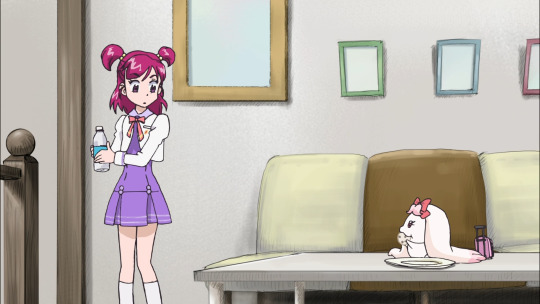
One shudders to imagine what inhuman thoughts lie behind those eyes... what dreams of chronic and sustained cruelty?
When Coco and Nuts show up with the other girls, there is a moment of shared recognition between the three as residents of Palmier Kingdom. Then the pest, who introduces herself as Milk, gushes that the two of them are the Princes of the Kingdom, which they brush off as not being important enough to bring up to the girls (but this will become important next season). She declares herself their Apprentice Caregiver, whatever that means, and is upset that the others are treating them so casually and that they’re doing labor themselves. Through further conversation, the parasite Milk explains how she got by by conning meals from, as she calls them, suckers. Suddenly, Nozomi realizes where her lunch went.
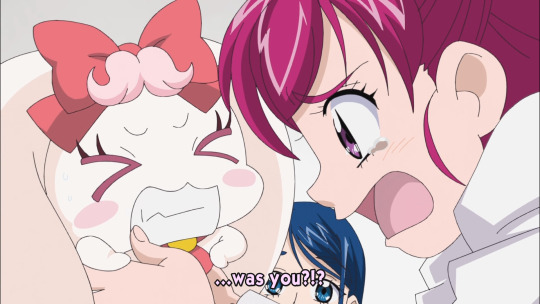
she takes it reasonably well
After some fuss, Milk shoos the girls out and they agree, having had enough excitement for the day. Then she tells Coco and Nuts that she will go purchase ingredients for dinner and runs out the door. They chase after her, because they’re concerned for her safety and she doesn’t know this town or anything about Nightmare. The princes end up in a park with Girinma, who has been dispatched to find them specifically, and he nearly kills them but for the triumphant return of Milk, who latches on like a facehugger, buying some time. Nozomi and the other girls appear, because they saw Coco and Nuts run out of the shop not long after their own departure and thought it was odd. They exposit to Girinma and Milk about how they’re going to revive the Palmier Kingdom with the Dream Collet and then transform into Precures.
Seeing his opportunity for revenge, Girinma turns a bench into a Kowaina to fight the girls. Dream jumps in and saves Milk from Girinma and places her safely off to the side before getting back into the fray. The team beats up on the monster, and at one point Girinma goes in for a killing blow on the fairies again but Dream and Lemonade stop him dead in his tracks.

Dream declares that they won’t let them cause Milk any more sadness, and everybody else chips in that she worked so hard and was extremely brave in getting to where she is now, in an unfamiliar world with dangerous enemies. Nozomi performs Dream Attack on the monster as Girinma flees and the park returns to normal.
Milk is sincerely amazed that these five are the legendary warriors..... but quickly catches herself and says she expected them to be more upstanding people. Nozomi tries to argue with her but the others shush her, pointing out that Milk has fallen asleep after exhausting herself that day, and we close on the pink devil’s sleeping face
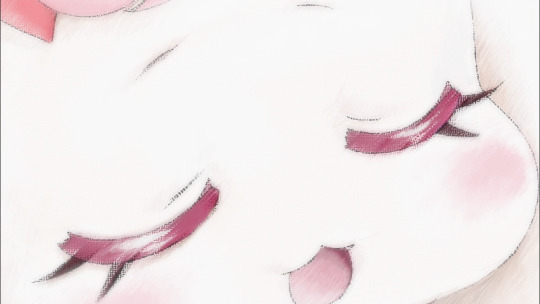
The Analysis
You may have noticed a hint of animosity towards Milk. I just want to state that it’s only a joke, I don’t dislike her.

I actively dislike her! She is insufferable, rude, ungrateful, smug, and downright mean. The bar for new fairies isn’t exactly high, considering the first impressions of Porun, Lulun, and Moop & Foop, but Milk is in a league of her own. Get used to me calling her a bitch, because she’s a bitch. She is all tsun, no dere (for now). Yes, she’ll get better as the show progresses, but she’s extremely difficult to tolerate in her early episodes. Porun and Lulun were just whiny, she is mean, and a source of trouble and conflict for everyone around her.
She isn’t swayed by them being the legendary warriors, and thinks they should be more impressive. She feels that Coco and Nuts should be placed on a pedestal and worshipped for the princes they are, not respecting their apparently lack of interest in their titles or their penchant for hard work. However, of all the girls, Nozomi in particular seems to be the target of most of Milk’s ire. Milk doesn’t see her positive aspects, only her clumsiness, gullibility, and other weaknesses. As the superior being, Milk takes it upon herself to remind Nozomi of her place as often as possible. It may be because she was the first one they met and Nozomi is upset at her for constantly stealing food and acting high and mighty. They certainly got off on the wrong foot, but despite attempts to ease the tension, Milk just isn’t interested.
I do have to commend her for her bravery at the end. Jumping in front of danger when she’s easily the least powerful of the group is commendable. She tried to stop Girinma the only way she knew how. She wanted to protect Nuts and Coco, and the future of the Palmier Kingdom. Her heart is in the right place, and this is the seed for her character arc over the next season and a half.
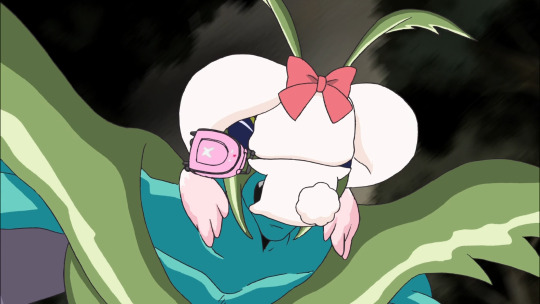
but she also has acid blood
The fight scene is intense, with lots of fun dynamic action shots as usual. It feels a bit abbreviated compared to some we’ve had, but the focus is on keeping Coco, Nuts, and Milk safe. There’s a sequence where Dream and Rouge are diving around the Kowaina’s arms which lends to some great stills:

And then at the climax of the fight as Girinma goes in for the kill, he’s drawn in exceptional detail:

Unfortunately the shot that immediately follows this is terribly-drawn, surprisingly one of the few examples of that in this episode. It’s the shot where Dream and Lemonade catch his arms, which I postd earlier. That rapid switch in quality was really jarring and disappointing for an otherwise strong episode.
I didn’t cover this in the plot summary but Girinma seems to be on his last ropes at Nightmare. Bunbee comments that despite being the champion of the raid on Palmier Kindom, he hasn’t managed to beat the Precures, and is likely to be terminated soon. He offers some advice, as old friends, to fight the fairies since that’s what he’s good at. If he had actually stuck to this advice, not engaging in the fight when the girls showed up, he may have won. But as we’ve seen, he’s very proud and lets his pride get in the way a lot, such as the time he was literally holding the Dream Collet but stopped to fight the girls. I’m going to recount his character more in episode 24, it’s a bit of a turning point for him.
Most of the humor in this episode again comes from the friction between Nozomi and Milk, and you can find plentiful examples in the gallery. There’s also some great facial expressions like such:
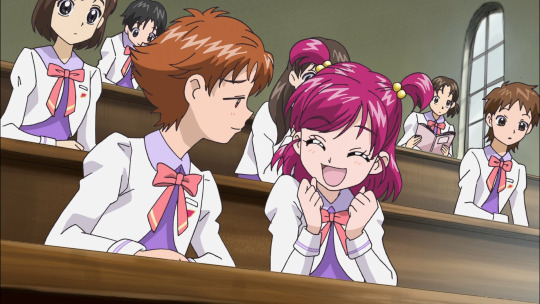

And last of all, I’m certain I mentioned this more than once when I was writing about FWPC, but Milk is at least the third example within this series alone of a voice actress for a main character previously playing a part in another season. Sendai Eri, who voices Milk, was previously Nagisa’s excitable friend Kubota Shiho in Futari wa Precure and Max Heart!

When the All Stars series begins, this also makes Shiho one of the few side characters to sometimes get speaking lines, because her actress is already on hand to record for a fairy, and you know they gotta have the fairies.
Next time, Milk struggles to find her role, and runs away! Look forward to it!
Pink Precure catchphrase count: 0 kettei!
19 notes
·
View notes
Text
HiGH&LOW THE MOVIE 3 FINAL MISSION (JM, 2017) (Sub. Esp)

DESCARGAR O VER ONLINE AQUÍ
Título: HIGH&LOW The Movie 3 Final Mission
País: Japón
Género: Acción
Duración: 118 min.
Fecha de estreno: 11 de noviembre, 2017
Dirección: Kubo Shigeaki, Nakakuki Tsuyoshi
Guion: Hiranuma Norihisa, Watanabe Kei, Kamijo Daisuke
Producción: Ueno Hiroyuki, Fujimura Naoto, Nakabayashi Chikako
SINOPSIS
A fin de ocultar la pasada corrupción del gobierno, el grupo Kuryu sigue un plan para destruir uan calle y construir un casino. Para detener al grupo Kuryu, los miembros de SWORD comienzan a moverse.
CAST
ASOCIACIÓN SANNOH
Iwata Takanori como Cobra
Suzuki Nobuyuki como Yamato
Machida Keita como Noboru
Yamashita Kenjiro como Dan
Sato Kanta como Tetsu
Sato Taiki como Chiharu
Yagi Masayasu como Ijuin Kabuto
Iwaya Shogo como Ken
Yamamoto Shogo como Hikaru
WHITE RASCALS
Keiji como Rocky
Endo Yuya como Koo
Inaba Yu como Kizzy
Yanagi Shuntaro como Kaito
Nishimura Ikki como Heidi
Hirose Tomoki como Marco
Nisikawa Shunsuke como Lassie
Matsuda Ryo como Cosette
Kyan Yutaka como Bito
Darvish Kenji como Shimura
INSTITUTO OYA
Yamada Yuki como Murayama Yoshiki
Suzuki Takayuki como Furuya Hideto
Ichinose Wataru como Seki Kotaro
Aoki Ken como Nakakuki
Kiyohara Sho como Nakabayashi
Jinnai Syo como Nakazono
RUDE BOYS
Kubota Masataka como Smoky
Sano Reo como Takeshi
Zen como P
Sano Gaku como Yu
Fujii Karen como Lala
DARUMA IKKA
Hayashi Kento como Hyuga Norihisa
Abe Ryohei como Sakyo
Ozawa Yuta como Kato Shu
Mizuno Masaru como Futa
Tanaka Shunsuke como Raita
Moriya Koji como Agyo
Izawa Yuki como Ungyo
DOUBT
Nakamura Aoi como Hayashi Ranmaru
Akiyama Shintaro como Takano
Takeda Kohei como Hirai
MIGHTY WARRIORS
Elly como Ice
Oya Kana como Sarah
Nogae Shuhei como Pearl
Shirahama Alan como Bernie
Anarchy como 9
Likiya como Diddy
Sukezane Kiki como Dixie
PRISON GANG
Naoto como Jesse
Sekiguchi Mandy como Pho
Iwanaga Joey como Brown
Nakatani Taro como Mocai
Jay como Nakamon
Takeru como Miou
Kido Yasuhiro como Akune
(EX)MUGEN
Akira como Kohaku
Aoyagi Sho como Tsukumo
HERMANOS AMAMIYA
Takahiro como Amamiya Masaki
Tosaka Hiroomi como Amamiya Hiroto
GRUPO KURYU
Tsugawa Masahiko como Kuze Ryushin
Iwaki Koichi como Kurosaki Kimitatsu
Kishitani Goro como Zenshin Yoshitatsu
Kato Masaya como Katsunari Ryuichiro
Sasano Takashi como Ueno Ryuhei
Takashima Masahiro como Minamoto Ryukai
Kinoshita Youka como Fujimori Tatsuo
Nakamura Tatsuya como Iemura Tatsumi
Saotome Taichi como Ryu Tatsuhito
Kobayashi Naoki como Kuki Genji
Kenchi como Nikaido
Onozuka Hayato como Kirinji
Takeda Kozo como Yoshida Kagetora
Kuroishi Takahiro como Udaka Shinichi
Yuki Jutta como Oba Kunimitsu
Shogen como Okido Ken
Shiroishi Tomoya como Eto
Araki Hideyuki como Fukuda
Watanabe Kohei como Yagi
ICHIGO-MILK
Kaede como Shiba
Sato Harumi como Oshiage
Yamaguchi Nonoka como Nonoriki
Kido Airi como Ichikawa
OTROS
Fujii Shuka como Naomi
Bando Nozomi como Ijuin Nika
Nakai Noemie como Furuno
Suzuki Rio como Eri
Horibe Keisuke como Natano Eichi
Hasegawa Hatsunori como Shinohara
Toyohara Kosuke como Saigo
Ikeue Kohei como Kikuchi
TRÁILER: https://www.youtube.com/watch?v=Jq7mAAjn8nw
#high and low#high&low#high & low#high&low the movie 3 final mission#exile tribe#jmovie#proyectos terminados#sub. español
7 notes
·
View notes
Photo

Well, I originally wanted to get this done by her birthday, but that’s okay. I’m only a day late...
Finally, a proper timeline ref for my Naruto OC, Nozomi Kubota. ^_^
If anybody ever deserved a ref pic like this it’s this girl...and I’m actually a little emotional right now. I’ve had this OC since 2009 and boy...what a ride. Because of her I’ve made so many memories and wonderful friends. I’ve laughed..cried..and been overly frustrated both by her and the series as I fight with the series rewrite I started in 2017 to add her in (I’m not giving up either, the girl refuses to die in the recesses of my mind, so I am determined to finish this story!)
In a way, Nozomi and I have grown up together, as I made her the year I graduated high school...so I guess it’s just sentimental for me to see a line up with her like this.
It’s also the perfect way for me to reveal her adult appearance haha! ;D
Many refs were used for poses (and I also redrew some of my old art for some of them, yay!)
I hope everyone likes this. <3
#Naruto OC#Nozomi Kubota#NarutoxOC#cat girl#psuedo jinchuriki#Naruto oc fanfiction#Naruto#Naruto: Shippuden#Naruto Blank Period#Naruto Next Gen
9 notes
·
View notes
Photo

Japan is a bewildering, beautiful country that is like nowhere else. There are so many amazing things to do in Japan that one trip is never enough—it has stolen our hearts and we can’t stop returning.
From ancient temples to futuristic skyscrapers, tranquil tea ceremonies to over-the-top arcades, relaxing hot springs to cosplay go-kart rides, Japan has so much to offer everyone.
In this post I share the best things to do in Japan divided into the categories Culture (for unique things you can only do in Japan), Fun (for all the quirky and futuristic stuff), Food (because the food is extraordinary and you must eat as much as possible), Spiritual (for all those wonderful temples and shrines) and Beautiful (for the gorgeous natural scenery).
Even on a short visit to Japan, you can choose a few experiences from each category for an unforgettable trip.
Cultural Things to Do in Japan
These unique things to do in Japan are activities you don’t find elsewhere and are the best ways of experiencing Japanese culture.
1) Spend a Night in a Ryokan
Our room at Hotel Mushashiya ryokan overlooking Lake Ashi in Hakone
For at least one night of your trip, I highly recommend staying in a ryokan, which is a traditional Japanese inn. Tatami mat rooms are elegant, minimalist spaces, usually with just a table and low chairs where you can enjoy green tea on arrival. Breakfast and dinner are often included in the price and served in your room.
The epic, multi-course meals are a highlight of a stay in a ryokan and have been some of our best meals in Japan. Ryokans can often cater to vegetarians and vegans, but let them know any dietary requirements in advance (you don’t get a choice of dishes).
After dinner, futons will be set up on the floor and can be surprisingly comfortable to sleep on.
Ryokans range from simple (such as guesthouses called minshuku) to ultra-luxurious, sometimes with private baths and views overlooking exquisite Japanese gardens. They are more expensive than regular hotels but are well worth it for the experience.
We loved our stay at Hotel Musashiya in Hakone (a top spot for seeing Mount Fuji) where our room and the public Japanese bath overlooked Lake Ashi. It’s reasonably priced, friendly, and the food was wonderful.
You can find many other ryokans all over Japan—search on Booking.com.
2) Soak in an Onsen
The classic Japanese experience is soaking in the steaming hot waters of an onsen (hot spring bath)—it’s a must for your Japan bucket list. Onsens come in many forms—indoor and outdoor, simple and luxurious, small and large. Most of them are shared, but some ryokans have private baths you can reserve.
Onsens can be a challenge for foreigners (they were for us at first!), as you must be completely naked (most are divided by gender). Make sure you shower thoroughly before you get in the bath too. It’s worth getting over your fears as they are such a relaxing experience.
3) Wander Around an Onsen Town in a Kimono
In winter kimonos at Kinosaki Onsen
If you want the full onsen experience, head to an onsen town. These small resort towns are usually in rural settings and feature many different onsens. They are popular destinations for the Japanese for relaxing getaways.
The best way to experience one is to stay in a ryokan. Some have their own onsens and usually include a pass to visit the other onsens in town. After putting on the provided yukata (cotton kimono) and geta (wooden sandals), you head out to hop from one onsen to another and relax in the steaming waters.
There are many onsen towns in Japan. We loved Kinosaki Onsen, which is easily accessible from Kyoto and Osaka and is particularly pretty in the spring when the canals are lined with cherry blossoms.
We stayed at the friendly Morizuya Ryokan which has two small onsens available for private use in the afternoon—perfect for your first time.
Read more about Kinosaki Onsen and onsen etiquette.
4) Watch a Geisha Dance
Geishas are one of the most fascinating aspects of Japan, especially if you’ve read Arthur Golden’s popular novel Memoirs of a Geisha about these highly-skilled women who entertain using traditional arts.
It’s hard to believe they still exist, but when we spent a month living on a traditional street in Miyagawacho in Kyoto (near the more well-known Gion area), we often saw them in brightly coloured kimonos emerging from wooden teahouses.
Rather than stalking geisha on the streets of Gion, I recommend watching them perform at one of the annual dances that take place every spring and autumn. The most famous is the Miyako Odori in April, but we went to the Kyo Odori instead, which doesn’t attract many foreign guests.
The performance was spectacular, and it was fascinating to get a closer look at the extravagant kimono, ornate hairstyles, and iconic white makeup these graceful women wear.
Top tip: Miyagawacho is the perfect area to stay in Kyoto for spotting geisha without the crowds of Gion. We rented a studio on VRBO that’s no longer available, but this three-bedroom townhouse was above us. Other options in this area are this traditional machiya with outdoor bath and a stylish machiya formerly owned by a geiko.
5) Admire Ukiyo-e Prints
Ukiyo-e or Japanese woodblock prints are uniquely Japanese and flourished during the Edo Period from the 17th to 19th centuries. The prints depict landscapes, regular life of ordinary people, and popular kabuki actors, sumo wrestlers, and geisha from the world of entertainment or “floating world”.
You can see ukiyo-e in many cities in Japan. We enjoyed the small Ota Memorial Museum in Harajuku, Tokyo which displays rotating exhibitions—we were lucky enough to see the 36 Views of Mount Fuji by Hokusai including the famous Great Wave off Kanagawa.
6) See Sumo Wrestlers in Action
Sumo is serious in Japan and the national sport is steeped in tradition. Matches still include rituals that date back to its ancient origins as part of the Shinto religion such as purifying the ring with salt.
You can see sumo wrestling at one of the sumo tournaments that happen a few times a year (book tickets in advance on Voyagin) or take a tour to a sumo stable in Tokyo or Osaka to see the wrestlers’ morning training session. Tournaments happen in Tokyo in January, May and September and Osaka in March.
I loved the novel The Street of a Thousand Blossoms by Gail Tsukiyama, which gave me a greater insight into sumo culture.
7) Watch a Kabuki Performance
Kabuki is a form of traditional Japanese theatre that dates back to the Edo Period. It includes drama, dance and music and the all-male performers wear elaborate makeup.
The best place to see a Kabuki performance is the Kabukiza Theatre in Ginza, Tokyo (English captions are available), but you might find performances in other major cities.
9) Dress Up as a Geisha
Hiring a kimono for the day and wandering the historic streets of Gion and Higashiyama is a popular activity in Kyoto with both Japanese and foreigners. There are many shops in Gion and the surrounding areas to rent them (the Yasaka Shrine area is a convenient place to start).
Although Kyoto’s ancient streets are the most common place to rent a kimono, you can find rental shops throughout Japan.
10) Gaze at Itchiku Kubota’s Stunning Kimonos
On a cloudy day at Kawaguchiko (when Mt Fuji did not emerge), we came across the Itchiku Kubota Art Museum on the shores of the lake. We didn’t expect much from a kimono museum, but Itchiku Kubota’s oversize kimonos are exquisite works of art and we were blown away.
Kubota made it his life’s mission to recreate a lost textile dyeing technique from the 16th century and the results are stunning. His kimonos are full of colour and texture and depict nature such as the changes in Mount Fuji through the seasons.
This museum isn’t on many things to do in Japan lists, but I think it’s a hidden gem, especially if you visit the beautiful onsite teahouse too.
11) Pay Your Respects at the Hiroshima Peace Museum
Head to Hiroshima to pay your respects to the victims of the atomic bombing at Hiroshima’s moving Peace Memorial Park. The park is beautiful and the museum is heartbreaking, riveting, and vitally important. Afterwards, explore the modern city that was almost entirely rebuilt after World War II.
Recommended Reading: 10 Unmissable Places to Visit in Japan
Fun Things to Do in Japan
12) Ride a Shinkansen (Bullet Train)
We adore train travel in Japan. The network is extensive and the trains are comfortable, clean, quiet, safe, and always on time (to the minute!).
Best of all are the shinkansen or bullet trains which travel at ultra-high speeds of up to 320 km/h (199 mph). They make travelling between major cities very fast—Tokyo to Kyoto, a distance of 450km (280 miles) can be covered in 2 hours 15 minutes by the fastest shinkansen Nozomi.
You can even ride fun themed bullet trains such as the Hello Kitty shinkansen which runs from Osaka to Fukuoka.
Shinkansen are expensive, but a Japan Rail Pass makes them more affordable as you can hop on as many as you’d like without a reservation.
Recommended Reading: Is a Japan Rail Pass Worth it?
13) Go-Kart Around Tokyo
Simon dressed up as Yoshi while go-karting in Tokyo
Go-karting is our pick for the most fun thing to do in Japan! Where else in the world can you dress up as your favourite character and drive go-karts on the real streets of a major city?
We went go-karting in Tokyo, but you can also do it in Osaka and Kyoto. I was terrified at first as we drove alongside buses and cars but ended up having so much fun! You used to be able to dress up as Mario characters but Nintendo shut that down.
Make sure you get an international driving permit from your home country before you come to Japan as they are strict about this requirement.
14) Enjoy a Day at DisneySea
DisneySea is one of the best Disney parks in the world with a unique nautical theme featuring ports like Mysterious Island with an erupting volcano and Mediterranean Harbor which looks just like Italy.
There are many fun rides at DisneySea as well as more adult-orientated attractions like seeing a Broadway show or drinking a cocktail in a 1920s lounge aboard a cruise liner.
Disney is easily accessible from central Tokyo in about 30 minutes, but on our third visit we stayed a short walk away at the inexpensive Hotel Mystays Maihama and loved avoiding rush hour travel and being able to take a break during the day.
I definitely recommend staying nearby if you want to visit the neighbouring Disneyland Tokyo park as well as you’ll need two full days.
15) Head up High for a City View
View from Harukas 300 in Osaka at night
Japanese cities are vast and impressive with towering skyscrapers and neon signs. I think they are best admired from above at night, so head up to an observatory in one of the tall buildings.
My favourite observatory is Harukas 300 in Osaka which has 360º views from the floor to ceiling windows and a cool open-air garden bar.
In Tokyo you can get a free view from the Tokyo Metropolitan Government Building in Shinjuku or enjoy VR rides along with the city skyline at the Sky Circus Sunshine 60 Observation Deck in Ikebukuro. Tokyo Tower is another popular viewpoint and looks like a red Eiffel Tower.
16) Rent a Karaoke Booth
Karaoke is one of the most typical Japan activities—everyone from teenagers to businessmen loves it here.
But don’t worry if you are shy—there’s no need to sing in public as in Japan you rent a private booth in one of the many huge karaoke buildings. The rooms are equipped with comfy seating, microphones, TV, and a tablet which you use to choose from a wide selection of songs. You can even order drinks and food.
We went to a branch of the budget Karaoke no Tetsujin chain in Tokyo and were surprised that the cost included a drink—it makes an affordable night out.
17) Be Spirited Away at the Studio Ghibli Museum
If you are a fan of Studio Ghibli films like Spirited Away and My Neighbor Totoro, don’t miss this whimsical museum in Tokyo where you can see props and drawings from the animations in a quirky building.
You must buy your tickets at least a month in advance—see the Ghibli website for details. If you miss out, Voyagin has more expensive last-minute tickets.
Recommended Reading: 17 Cool Things to Do in Tokyo
18) Enter the World of Harry Potter at Universal Studios Japan
Harry Potter World at Universal Studios Japan
Universal Studios Japan in Osaka is a must for Harry Potter and theme park fans.
The highlight is the immersive Wizarding World of Harry Potter where you can wander the snowy cobbled streets, stroll through Hogwarts, drink butterbeer, shop for sweets in Honeydukes, and even cast your own spells if you buy a magic wand.
Elsewhere in the park, there are plenty of rides for thrill-seekers including Hollywood Dream and The Flying Dinosaur—the scariest rollercoaster I’ve ever been on!
See our favourite Universal Studios Japan rides.
The park gets extremely busy, so avoid weekends and buy your tickets in advance. Consider purchasing an Express Pass to skip the queues.
19) Experience Sensory Overload at the Robot Restaurant
The Robot Restaurant is one of the weirdest things to do in Japan. It’s not actually a restaurant but is a bizarre, high-energy show featuring robots, dragons, ninjas, blue-haired dancers, creepy clowns, guitarists on swings, drummers, and lots of flashing neon lights. It’s incredibly loud, obnoxious, and hilarious.
Don’t pay full price on the door for the Robot Restaurant—buy discounted tickets in advance from Voyagin.
20) Ride the Don Quixote Ferris Wheel in Dotonburi
Don Quixote Ferris wheel in Dotonburi, Osaka
A nighttime visit to Osaka’s Dotonbori neighbourhood is a must-do in Japan with its overwhelming display of neon, giant food models, and many restaurants and food stalls.
Overlooking the river you can ride a unique Ferris wheel in the building of the massive Don Quixote store (great for cheap souvenirs). It’s the strangest looking Ferris wheel as it’s built onto the facade of the store and you ride in a capsule that follows an oval shape up to 77 metres high with views of the river and city.
Top tip: We recommend this spacious Airbnb apartment in the Shinsaibashi neighbourhood of Osaka. It’s walkable to Dotonburi but is in a much quieter area with some great shops and restaurants nearby.
21) Play Taiko Drums in an Arcade
There are so many video game arcades in Japan that you won’t be able to miss them (they are loud and neon!). There’s a wide array of games, and one of the most fun is playing the huge Japanese taiko drums.
The most unique arcade we visited in Japan was the Anato No Warehouse in Kawasaki near Tokyo, which is themed like a seedy back alley in Hong Kong’s Kowloon walled city.
If you want to play real Taiko drums, you can take a class in Tokyo.
22) Get Lost in the Colourful TeamLab Borderless Museum
TeamLab Borderless is a unique digital art museum in Tokyo. It’s an immersive experience where you walk around in the dark (there’s no map) and interact with a series of colourful exhibitions of light and sound displays.
It’s like no museum I’ve ever been to and is worth braving the crowds for. Make sure you book tickets in advance as it usually sells out, and arrive just before opening.
23) Brave the Shibuya Crossing
One of the most famous sights in Tokyo is the insane Shibuya Crossing, the world’s busiest pedestrian crossing. Outside Shibuya Station as many as 2500 people cross the road every time the light changes, somehow managing to avoid bumping into each other.
You can head into the crowd yourself or view the action from above in one of the neighbouring buildings (Starbucks is the most popular spot). It looks best at night when all the neon signs are lit up.
Best Japan Activities for Foodies
Food in Japan is an adventure and an art form. Japanese cuisine is universally delicious and beautifully presented whether you pick up a snack from a 7-Eleven (yes, this is the only country I recommend this) or indulge in multi-course fine dining.
Being a vegetarian can be a challenge if you don’t plan in advance, but follow our vegetarian in Japan tips and you’ll eat some of the best meals of your life.
We love eating in Japan and there are many fun and tasty culinary experiences to enjoy.
24) Order Ramen from a Vending Machine
Ramen, or noodle soup, may have its origins in China, but there’s now a no more classic Japanese food experience than enjoying a steaming bowl of ramen. Not only is it utterly delicious, but it’s also one of the quickest and cheapest meals you can find.
In the simplest ramen joints, you make your selection and pay at a vending machine at the entrance and then hand over your ticket to the chef behind the counter who will cook the soup of your choice.
Most ramen is made with meat (or occasionally fish) broth and topped with pork, but vegetarian ramen is becoming more common. Read our vegetarian Tokyo guide for our favourite veggie ramen joints and look out for the chains Kyushu Jangara Ramen and Chabuton.
25) Make Your Own Takoyaki
Iduco Self Tacoyaki bar in Osaka
Takoyaki is a street food from Osaka that consists of batter cooked in ball shapes on an iron plate and stuffed with octopus. It’s not something vegetarians can usually eat, so we were ecstatic to find a tiny takoyaki stand in Osaka that not only does a vegetarian version but also lets you make your own.
The owner of Self Tacoyaki Bar Iduco is a friendly guy, and it was fun making our messy takoyaki and filling them with green onion, pickled ginger, mushroom, konnyaku, puffed rice, and dried seaweed.
26) Try Okonomiyaki
Okonomiyaki is another classic Japanese dish found all over the country but especially in Osaka and Hiroshima. It’s a thick savoury pancake made with a batter of flour and eggs and filled with cabbage and whatever else you want. Hiroshima-style okonomiyaki also contains noodles.
In some okonomiyaki restaurants, you make your own, while in others it’s made on an iron griddle in front of you. It’s a hearty and inexpensive meal.
27) Take a Cooking Class
A cooking class is one of the best things to do in Japan for foodies as you can learn more about Japanese food culture and take home recipes for your favourite dishes.
There’s a wide variety of cooking classes available in Japan where you can learn to make okonomiyaki, sushi, tempura or regional dishes. On our next trip I want to take this vegan ramen making class near Osaka.
We loved our class with Emi at Uzuki Cooking Class who teaches home-style Japanese cooking in her kitchen in Kyoto. We made a series of beautiful vegetarian dishes using local ingredients.
28) Indulge in a Kaiseki Meal
One of the 12 courses of our vegan feast at Bon in Tokyo
If ramen is one of the cheapest Japanese meals, kaiseki is the most expensive. Kaiseki is a traditional multi-course meal of the highest quality. A series of small, exquisitely presented dishes are served to guests, usually in beautiful tatami mat rooms. Ingredients are always in season and the presentation enhances the seasonal theme.
Kaiseki meals can be very expensive, but they are a unique experience. Lunch is more affordable than dinner.
If you are vegetarian, look out for the meat-free alternative shojin ryori instead—our favourite place for this is Bon in Tokyo.
29) Drink Matcha with Wagashi
Matcha is a powdered green tea that has a richer flavour than regular tea. A classic Japanese activity is enjoying a bowl of matcha in a traditional tea house accompanied by wagashi, beautiful sweets typically made from rice, red beans, and sugar.
There are many tea houses in Kyoto—we had a great experience at Ippodo Tea Shop. We also loved the view from the tea house at Itchiku Kubota Art Museum in Kawaguchiko.
30) Learn the Art of the Tea Ceremony
Tea ceremony at Gyokusen-en gardens in Kanazawa
Tea isn’t just a drink in Japan and I highly recommend experiencing a traditional tea ceremony to learn more about this important part of Japanese culture.
Kyoto is the home of the tea ceremony, so there are many options such as this authentic tea ceremony near the Golden Temple or this tea ceremony in a traditional townhouse. In Tokyo you can do a tea ceremony at the Bonsai Museum. Some have the option of wearing a kimono which adds to the atmosphere.
We did a tea ceremony at the gorgeous Gyokusen-en Gardens in Kanazawa, which is harder to book than the suggestions above. Ms Nishida, who is from the fifth generation of the family who owns the gardens, took us through the ritual and we learnt the appropriate phrases, how to appreciate the tea bowl, and the concept of “ichi-go ichi-e” which means cherishing the moment as it will never happen again.
Recommended Reading: Our 2 week Japan itinerary includes Kanazawa.
31) Drink Sake at an Izakaya
From the tranquility of a tea room to the boisterousness of an izakaya, Japan is all about contrast. An izakaya is a Japanese pub where you can drink sake (rice wine), beer and other alcoholic drinks accompanied by small tapas-like plates of food.
If you don’t feel brave enough to venture into an izakaya yourself, you can take a tour in Tokyo or Osaka.
32) Eat Sushi
Our vegetarian sushi feast in our room at Morizuya Ryokan in Kinosaki Onsen
Sushi is Japan’s most famous dish so, of course, you’ll want to try it in its homeland. Eating sushi in Japan is different from elsewhere and there are strict rules—see this sushi in Japan guide for tips.
Sushi comes in many forms. While it all involves rice prepared with sushi vinegar, it doesn’t all include raw fish. Vegetarian sushi made with tofu, cucumber, or other vegetables is harder to find, but you can read our vegetarian Japan guide for ideas.
You can eat sushi everywhere from convenience stores to fine dining restaurants. The most famous (and exceedingly expensive) restaurant is Sukiyabashi Jiro in Tokyo—you can learn more about the revered chef in the documentary Jiro Dreams of Sushi (also available on Netflix).
It’s a difficult restaurant to get a reservation for, and you can’t just call yourself, but Voyagin can make a reservation for you. A more affordable option is Sukiyabashi Jiro Roppongi, which is run by his son.
Another popular place to try sushi is the Toyosu Fish Market—you can take a private tour or visit yourself (but you’ll need to apply in advance to see the early morning tuna auction).
33) Enjoy a Bento Box on a Train
A bento box is a Japanese lunchbox featuring a range of small dishes with a balance of flavours, textures, and food groups. You can find them in train stations (where they are called ekiben and use local ingredients), convenience stores, and department store food halls.
This being Japan, they are works of art and very tasty. They are ideal for long train rides and picnics in the park.
A typical bento features rice, meat or fish, and pickled vegetables. Vegetarian bentos are not easy to find, but we did get one at Matsumoto in the Isetan department store near Shinjuku Station in Tokyo.
34) Hanami Under the Cherry Blossoms
Locals enjoying hanami at Himeji Castle
Hanami is a Japanese custom of viewing the transient sakura (cherry blossoms) that bloom for a few weeks in spring (usually late March to mid-April in Tokyo and Kyoto).
The most popular way to enjoy the blossoms is with a picnic under the trees. The Japanese gather in large groups with food and drinks for parties that often last all day and into the night.
To enjoy your own hanami, you can pick up a bento box from a department store or there are many picnic options in convenience stores as well as beers and sake. Look out for sakura-themed items like mochi, kitkats, and even beer.
Our favourite hanami spots were Handayama Botanical Garden in Okayama and Shinjuku Gyoen National Garden in Tokyo where we enjoyed three picnics in a week under the late-blooming cherry trees.
Top Tip: Airbnbs are an affordable option in Tokyo and Shinjuku is our favourite area to stay. We recommend this affordable Airbnb studio that’s a short walk from Shinjuku Gyoen.
35) Order Hot Coffee or Soup from a Vending Machine
In Japan you’ll find vending machines everywhere—in train stations, on almost every street corner, and even on hiking paths. They are very convenient as you’ll never go thirsty.
Most vending machines sell drinks—cold green tea, milk tea, soft drinks, energy drinks, juice (some with jelly chunks), and water. It’s not just cold drinks, though—in the colder months you can buy a can of hot coffee, tea, and even corn soup to go! You can tell they are hot as they’ll have a red label (rather than blue for cold drinks). You can also find vending machines that sell alcohol.
It may not be the best coffee in the world, but Simon loved the convenience of being able to pick up a can of hot coffee anywhere, especially on cold mornings when we had a train to catch. His favourite was Tully’s—he found the more common Boss coffee (randomly advertised by Tommy Lee Jones) rather gross.
Spiritual Things to Do in Japan
Visiting a Buddhist temple or Shinto shrine is a must do in Japan even if you aren’t religious (we’re not). They are diverse, beautiful, peaceful (sometimes), and fascinating with many rituals to observe. They are often set amongst lovely natural settings in forests or on mountainsides.
The best places to visit temples and shrines are Kyoto (Japan’s capital for 1000 years until 1868) and Nikko (a UNESCO World Heritage Site a few hours north of Tokyo), but you can find them all over the country even in modern Tokyo and Osaka.
Read our Kyoto temples guide for more on the differences between temples and shrines.
36) Stay in a Temple at Koya-San
One of the most unusual things to do in Japan is spend the night in a temple in the sacred mountain town Koya-san, about 90 minutes from Osaka.
Many temples offer shukubo or temple lodging where you can sleep in tatami mat rooms, soak in communal onsen baths, and enjoy delicious shojin ryori vegetarian Buddhist meals. Early in the morning you can join the monks for their chanting and fire ceremony.
We stayed in the cheapest temple accommodation, Haryo-in, but it’s quite basic and not available to book online. Next time I’d pay more for one of the more traditional temples like 1000-year-old Eko-in.
37) Hike Through Torii Gates at Fushimi Inari
My favourite shrine in Japan and one of the most popular things to do in Kyoto is the unique Fushimi Inari. Thousands of bright orange torii gates snake up through a forest on the side of a mountain and it takes about 90 minutes to complete the full circuit (which I recommend as it’s much quieter at the top).
Fushimi Inari is one of the top tourist attractions in Japan and gets incredibly busy, so I highly recommend arriving before 7 am or after 8 pm to avoid the worst of the crowds.
Although I prefer it early in the morning, hiking it at night feels more adventurous with a slightly spooky atmosphere (watch out for wild boars!). The shrine is free and open 24 hours.
38) Visit the Golden Temple
Another Kyoto highlight is Kinkaku-ji or the Golden Temple. We expected it to be overrated (and it is very crowded), but the shimmering gold pavilion reflected in a pond amongst leafy gardens lived up to the hype.
39) Get Your Fortune Told at a Temple or Shrine
Omikuji are fortune-telling paper strips that can be bought at Japanese temples and shrines. The fortunes range from great good luck to great bad luck (luckily the worst we’ve got is “pretty good”). Some of the more popular temples like the Golden Temple in Kyoto have fortunes in English.
If you get a bad fortune, make sure you leave it at the temple to avert the bad luck—there are dedicated areas to tie them. If it’s a good fortune you should carry it with you.
40) Meditate at a Zen Garden
Zen Buddhist temples usually feature kare-sansui or dry landscape gardens made from rocks and gravel carefully raked into patterns that suggest rippling water. They are simple, elegant, and the perfect place to meditate.
Kyoto is the best place to find Zen temples. Ryoan-ji Temple is the most famous (and crowded), and we enjoyed the gardens at Kennin-ji and Kodai-ji (especially when the cherry tree is in bloom). At Entoku-in we had the chance to create our own miniature garden.
41) Visit a Temple at Night
Night illuminations at Kiyomizu-dera in Kyoto
In the spring cherry blossom and autumn leaf seasons some temples open at night. They are beautifully illuminated, sometimes feature special light shows, and it feels like a different experience visiting in the dark. We especially enjoyed night visits to Kiyomizu-dera and Kodai-ji in Kyoto.
42) See the Giant Buddha at Nara
Nara is a wonderful day trip from Kyoto. It was Japan’s first permanent capital and is full of historic treasures including many UNESCO world heritage sites.
The highlight is the immense Daibutsu-den (Hall of the Great Buddha) at Todaiji. It’s the largest wooden building in the world and houses the 15-metre tall gold and bronze statue of Buddha that dates back to 751.
43) Explore the Temples at Nikko
Temple fans shouldn’t miss Nikko, a mountain town full of UNESCO World Heritage temples a few hours north of Tokyo. Many people visit on a day trip, but it’s worth staying overnight to get an early start and avoid the crowds.
Toshogu Shrine is the main attraction and features more than a dozen lavishly decorated red and gold buildings amongst huge, ancient cedar trees. I also recommend playing games at atmospheric Futarasan-jinja and hiking up the mountain to the tranquil Takino shrine.
44) Get Off the Beaten Track at Otagi Nenbutsuji
Otagi Nenbutsuji
My favourite temple in Kyoto is the quirky Otagi Nenbutsuji in the lovely Arashiyama neighbourhood. It’s much quieter than other temples in the area, and the shady temple complex features 1200 stone sculptures of the Buddha’s disciples all with different facial expressions and poses from scary to serene.
Best Beautiful Japan Attractions
There’s so much more to Japan than the cities. You’ll find many gorgeous mountains, lakes, islands, waterfalls, rivers, rice fields, and forests. Temples and shrines are also often in beautiful natural settings, so see the section above as well.
Here are just some of the top things to do in Japan in nature. There are many other options to experience Japan on foot, bike, boat, and skis.
45) Attempt to See Mount Fuji
Mount Fuji just after sunrise at Lake Kawaguchi
For many people the iconic Mount Fuji is a top Japan sightseeing spot. The perfectly shaped volcano is Japan’s highest mountain at 3776 metres, and it’s especially lovely in the winter and spring when it is snow-capped.
The best towns to see Mount Fuji from are the hot spring resort Hakone or the Fuji Five Lakes area (especially the lakeside town Kawaguchiko)—we’ve enjoyed visits to both. Mount Fuji is elusive, though, and is often obscured by cloud. It’s best to allow a few days in the area to increase your chances of seeing the peak.
You can also climb Mount Fuji but only in July and August and it’s a challenging climb.
In Kawaguchiko we stayed at Kawaguchiko Lakeside Hotel, which is close to the lake and has Mount Fuji views. It’s not fancy, but it’s reasonably priced for the area, and our room (with separate living room) was our largest in Japan.
46) Loop Around Hakone
While Hakone is a great place to see Mount Fuji, it also has a lot to offer when the mountain is hiding behind clouds. With the Hakone Freepass you get unlimited rides on transport in the area and can follow a fun loop which includes a pirate ship cruise across Lake Ashi, ropeway (cable car) up a mountain to Owakudani, an active volcanic valley, and a train through the mountains.
We loved staying at the modern ryokan Hotel Musashiya on the shores of Lake Ashi in Moto Hakone where we had fantastic views of the lake from our room and the onsen. It’s close to Hakone-jinja shrine where a large red torii gate overlooks the lake.
47) Go Cherry Blossom Viewing
Cherry blossoms by the canal in Kinosaki Onsen
Japan in spring lives up to the hype. The fleeting sakura (cherry blossoms) are truly spectacular, and they are everywhere, not just limited to a certain park or canal. It’s a joyous time of year when locals hit the parks for hanami picnics and eat cherry-blossom themed food.
Kyoto and Tokyo are excellent famous cherry blossom spots, but we also enjoyed Okayama where it wasn’t as crowded. Early April is usually the peak sakura season, but it is never guaranteed.
48) Cycle the Countryside
A fantastic way to experience rural Japan is by bike. We really enjoyed a group cycling tour with Satoyama Experience from the adorable town of Hida-Furukawa near Takayama. We learnt about local traditions and cycled past rice fields, rivers, mountains, and idyllic villages.
We also did a DIY half day trip along the Kibi Plain Bike Path past beautiful off-the-beaten-path temples, rice fields, and cherry blossoms. From Okayama take the train to Bizen-Ichinomiya where you can hire a bike one-way to Soja then hop on the train back from there.
49) Walk Through a Bamboo Forest (But Not in Arashiyama)
Bamboo forest at Kodai-ji temple on a rainy night
There’s something magical and very Japanese about a bamboo forest with its towering green stalks swaying in the breeze. By far the most popular bamboo forest in Japan is in Arashiyama in Kyoto, which is considered one of the top things to see in Japan.
Honestly, it’s so crowded that I much prefer the smaller bamboo groves that you find in temples such as Kodai-ji. I encourage you to seek out a more peaceful bamboo forest for yourself.
50) Visit the Art Island of Naoshima
The famous yellow pumpkin on Naoshima island
Naoshima is a rural island in the Seto Inland Sea that has been transformed into a hub of contemporary art. We visited as a day trip from Okayama and hired e-bikes to cycle the island (it’s not very big).
As well as enjoying beautiful coastal views we saw Yayoi Kusama’s famous yellow and red pumpkins and visited several art museums and the unique Art House Project with installations spread over abandoned houses.
51) Stroll a Japanese Garden
You can’t visit Japan and not take a stroll through a traditional garden. There are many styles of Japanese gardens and they all highlight the beauty of nature and avoid artificial components where possible.
Classic elements include moss-covered rocks, carp-filled ponds, stone lanterns, wooden teahouses, maple trees, and cherry blossoms. Many are found at temples.
There are so many to choose from, but some of my favourites are the tiny but exquisite Gyokusen-en Gardens in Kanazawa, Shinjuku Gyoen in Tokyo, and the grounds of Jojakko-ji Temple in Arashiyama, Kyoto.
52) Hike the Historic Nakasendo Trail
The Nakasendo Trail connected Tokyo and Kyoto during the Edo period. Along the journey through the mountains there were many “post towns” where lords and samurai could stop to rest at traditional inns and soak in hot springs.
You can still do a half-day hike on the most scenic part of the trail from Tsumago to Magome (5 miles/ 3 hours). A typhoon prevented us from doing the walk, but we still enjoyed our stay in the picture-perfect traditional Japanese village of Tsumago, which is well-preserved with many wooden buildings.
53) See Traditional Thatched Houses at Hida Folk Village
Traditional grass roof houses at the Hida Folk Village
We thought the Hida Folk Village near Takayama would be too touristy, but the open-air museum is a beautiful place, especially in the autumn. It features traditional thatched houses from across the Hida region that were moved to the museum in 1971. It was fascinating to see what life was like for rural Japanese in the Edo period.
Another option if you have more time is to stay in one of the Gassho-style thatched houses in the village of Shirakawa-go (50 minutes by bus from Takayama).
54) Walk from Kibune to Kurama
A worthwhile half-day trip from Kyoto is to take a 30-minute train ride to the village of Kibune in the Kitayama Mountains. From there you can walk through the forest over the mountain to Kurama-dera, a temple with fantastic views.
Continue to the village of Kurama where you can have a tasty vegetarian lunch at Yoshuji or soak in an onsen before hopping on the train back to Kyoto. Or in the summer you can hike it in the opposite direction and finish with a meal on a platform over the river in Kibune.
It’s an easy, peaceful, and beautiful escape from the city.
Planning Your Japan Itinerary
See our post on the best places to visit in Japan for our top recommendations.
Kyoto and Tokyo are the most popular destinations for first-time visitors and are a good combination for seeing the traditional and modern sides of the country.
I also recommend spending at least one night (more if you have time) in more rural locations such as Hakone (for Mount Fuji), Takayama (for traditional wooden houses), Nikko (for temples), or Koya-san (for an overnight temple stay).
Here’s our recommended Japan 2 week itinerary.
Japan Travel Tips
See our other Japan blog posts for more tips:
Planning a Trip to Japan: Dos and Don’ts
17 Cool Things to Do in Tokyo
Is a Japan Rail Pass Worth it?
Where to Stay in Japan: A Guide to Accommodation Options
15 Fascinating Books to Read Before Visiting Japan
Vegetarian Survival Guide to Japan
I hope this post has given you plenty of ideas for what to do in Japan. Enjoy exploring this weird and wonderful country!
0 notes
Text
High&Low cast
Sanno Rengokai
Takanori Iwata, Nobuyuki Suzuki, Keita Machida, Kenjiro Yamashita, Kanta Sato, Taiki Sato, Masayasu Yagi, Shogo Iwaya, Shogo Yamamoto
White Rascals
Keiji Kuroki, Yuya Endo, Yu Inaba, Shuntaro Yanagi, Sho Kiryuin, Yutaka Kyan, Jun Utahiroba, Kenji Darvish, Tomoki Hirose, Ryo Matsuda, Shunsuke Nishikawa, Ikki Nishimura
Oya Koukou
Yuki Yamada, Takayuki Suzuki, Wataru Ichinose, Takahide Suzuki, RYU, Goki Maeda, Ken Aoki, Sho Kiyohara, Sho Jinnai
RUDE BOYS
Masataka Kubota, Reo Sano, ZEN, Tasuku Nagase, Gaku Sano
Daruma Ikka
Kento Hayashi, Ryohei Abe, Yuta Ozawa, Masaru Mizuno, Shunsuke Tanaka, Koji Moriya
Ichigo Miruku
Fujiko Kojima, Ayano Kudo, Kaede, Harumi Sato, Nonoka Yamaguchi, Airi Kido
DOUBT
Aoi Nakamura, Shintaro Akiyama, Kouhei Takeda
MIGHTY WARRIORS
ELLY, Kana Oya, Shuhei Nogae, Alan Shirahama, ANARCHY, NAOTO, Mandy Sekiguchi, LIKIYA, Kiki Sukezane
Amamiya Kyodai
TAKAHIRO, Hiroomi Tosaka, Takumi Saitoh
MUGEN
AKIRA, Sho Aoyagi, Hiroyuki Takaya, Yushin Okami, Arata Iura
Leaders of Kuryu Group
Masahiko Tsugawa, Koichi Iwaki, Goro Kishitani, Masaya Kato, Takashi Sasano, Masahiro Takashima, Houka Kinoshita, Tatsuya Nakamura, Taichi Saotome
Members of Kuryu Group
Naoki Kobayashi, Kozo Takeda, Takahiro Kuroishi, Jutta Yuki, SHOGEN, Kenchi Tachibana, Hayato Onozuka, Tomoya Shiroishi, Hideyuki Araki, Kouhei Watanabe
also starring
Joey Iwanaga, Taro Nakatani, JAY, TAKERU, Yasuhiro Kido, Kousei Amano, Shuuka Fujii, Karen Fujii, Nozomi Bando, Kohei Ikeue, Noémie Nakai, Mai Hakase, Hatsunori Hasegawa, Hiroyuki Watanabe, Kenichi Yajima, Keisuke Horibe, Yosuke Saito, Rio Suzuki, YOU, Naoko Iijima, Kosuke Toyohara, Kyoko Koizumi
#high&low#LDH casually shoving their whole talent pool into these movies#let's play a game called spot all the toku actors
27 notes
·
View notes
Photo


Tokyo Ghoul (2017)
Masataka Kubota as Ken Kaneki
Fumika Shimizu as Tōka Kirishima
Yū Aoi as Rize Kamishiro
Nobuyuki Suzuki (ja) as Kōtarō Amon
Yo Oizumi as Kureo Mado
Kunio Murai as Yoshimura
Hiyori Sakurada as Hinami Fueguchi
Shoko Aida as Ryōko Fueguchi
Kenta Hamano as Enji Koma
Nozomi Sasaki as Kaya Irimi
Shuntarō Yanagi as Renji Yomo
Ken Kaneki (Masataka Kubota) is a university student. He becomes injured by Rize, a human eating ghoul. Ken is saved from the ghoul when a steel frame falls on Rize. They are both sent to the hospital. Ken receives an organ transplant from Rize and becomes a half ghoul.
youtube
6 notes
·
View notes
Photo

Tokyo Ghoul Official Trailer (2017) starring Yû Aoi, Masataka Kubota, Shun'ya Shiraishi Trailer for Tokyo Ghoul, which was released to international markets under the title Tôkyô Gûru…
#Action#Drama#Duncan#Fumika Shimizu#Hiyori Sakurada#Horror#Kenta Hamano#Kentarô Hagiwara#Kunio Murai#Masataka Kubota#Minosuke Bandô#Movie Trailers#Nobuyuki Suzuki#Nozomi Sasaki#Seika Furuhata#Shôko Aida#Shun&039;ya Shiraishi#Shuntarô Yanagi#Yô Ôizumi#Yû Aoi
0 notes
Photo
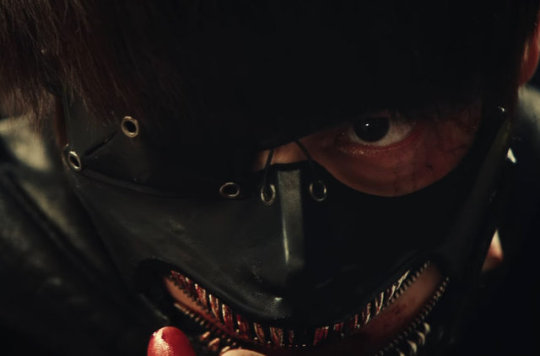
Tokyo Ghoul Live-Action: Ηθοποιοί, ημερομηνία πρεμιέρας, trailer More: https://on.hqm.gr/i8
Δείτε το trailer, την ημερομηνία πρεμιέρας και τους ηθοποιούς από την live action ταινία που βασίζεται στο manga Tokyo Ghoul.
by DJ Coke for HQM.GR
#Action#Adaptations#Drama#Fumika Shimizu#Hiyori Sakurada#Horror#Kenta Hamano#Live Action#Masataka Kubota#Nobuyuki Suzuki#Nozomi Sasaki#Otaku#Shoko Aida#Shuntaro Yanagi#Tadayoshi Kato#Thriller#Tokyo Ghoul#Yo Oizumi#Yuu Aoi#Comics#Entertainment#Manga#Movie Trailers#Movies
0 notes
Text
The Last Cop - Official trailer 2017 - Shochiku
New Post has been published on https://goo.gl/xJ9qdR
The Last Cop - Official trailer 2017 - Shochiku
30 years ago, Kosuke Kyogoku (Toshiaki Karasawa) was a young police officer. He went after the dangerous criminal Kagura, but had an accident and fell into a coma. Now, 30 years later, Kosuke wakes up from his coma. He is now in his 50's and the world has completely changed. He begins to work again as a cop and partners with young detective Ryota (Masataka Kubota). Ryota is geeky and timid, while Kosuke is brash and aggressive. Their new story begins. Directed by: Ryuichi Inomata Cast: Toshiaki Karasawa, Masataka Kubota, Nozomi Sasaki, Naohito Fujiki (function(d,s,id)var js,stags=d.getElementsByTagName(s)[0];if(d.getElementById(id))return;js=d.createElement(s);js.id=id;js.src="http://g-ec2.images-amazon.com/images/G/01/imdb/plugins/rating/js/rating.min.js";stags.parentNode.insertBefore(js,stags);)(document,'script','imdb-rating-api');
#Action#Japanese#Masataka Kubota#Naohito Fujiki#Nozomi Sasaki#Ryuichi Inomata#The Last Cop#Toshiaki Karasawa
0 notes